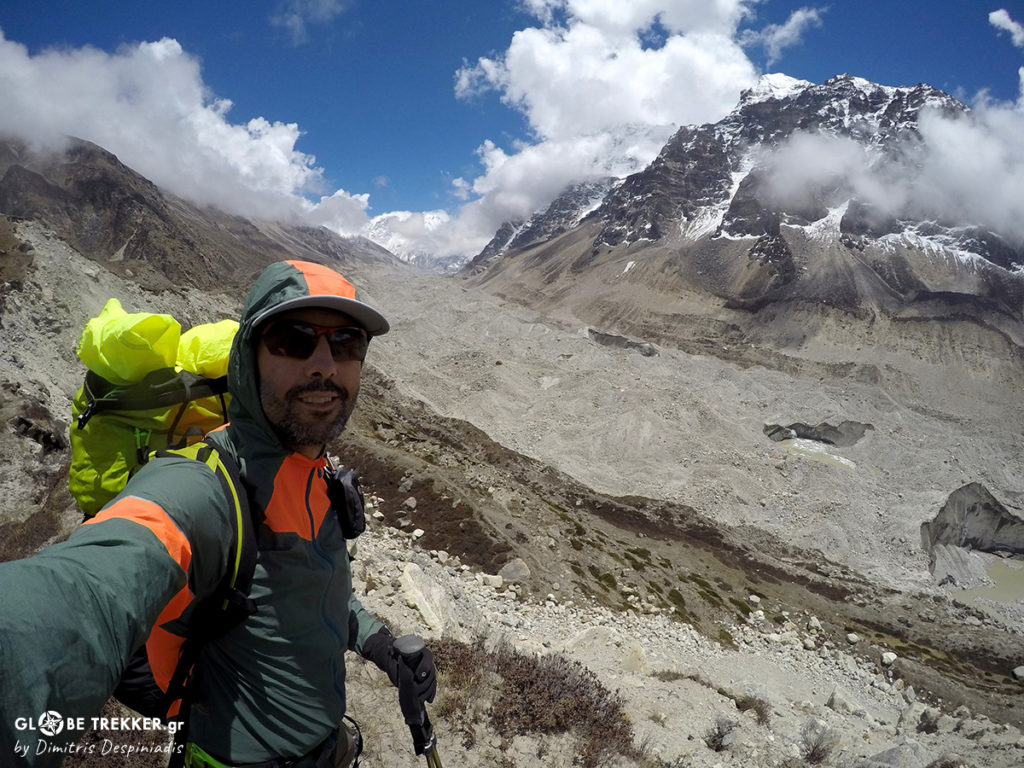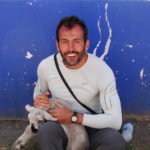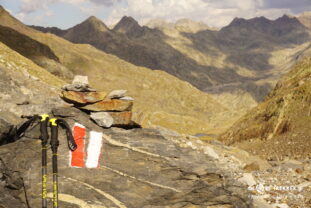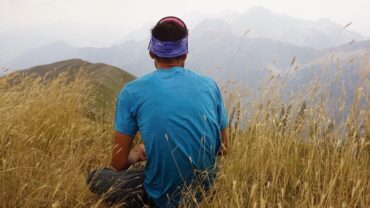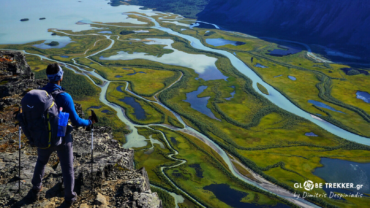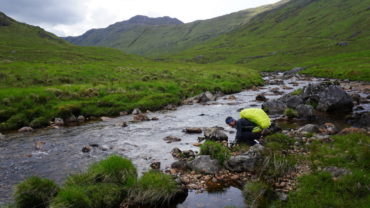In Snow Leopard’s habitat !
May 14, 2016
Llonak, far, Eastern Nepal
The sound of a hissing and an incomplete cry broke the silence in the mist ! We run out of the hut into the bitter cold, immediately. The only thing that we could barely see was the flock of bharals ( Himalayan blue sheep ) disappearing behind the moraine wall on our right.
“It sounded like a wild animal ! Don’t you think…?” suggested meaningfully my friend Dimitris.
“Yeah sure… But it could be Yeti as well” I replied, bursting into laughs.
I could not believe there was the slightest possibility the sound we just heard to belong to such a rare- almost mythical- creature. The following day I learned my lesson well. To ALWAYS leave room for the unexpected, even if that is called Snow Leopard !
But how did the two of us end up in its natural habitat, a world of rocks and snow that could inspire religions ?
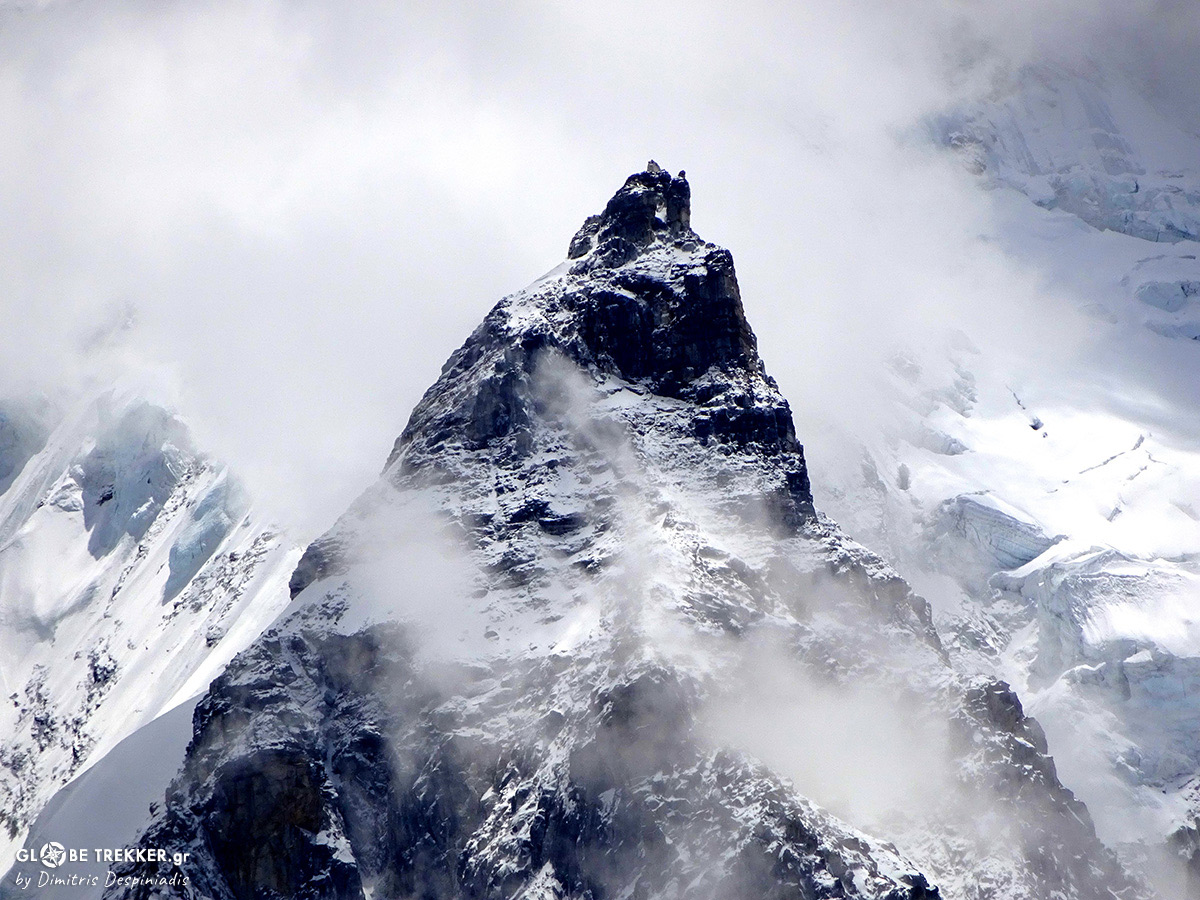
The remote valleys surrounding Kangchenjunga and Makalu massifs ( 3rd and 5th highest mountain on Earth respectively ) in far-Eastern Nepal are considered among the wildest and most diverse of the entire Himalaya !
In full contrast to the touristy trekking areas of the country ( Khumbu, Annapurna, Langtang ), their logistics are not that straightforward and facilities are primitive. The above facts guarantee an authentic travel experience !
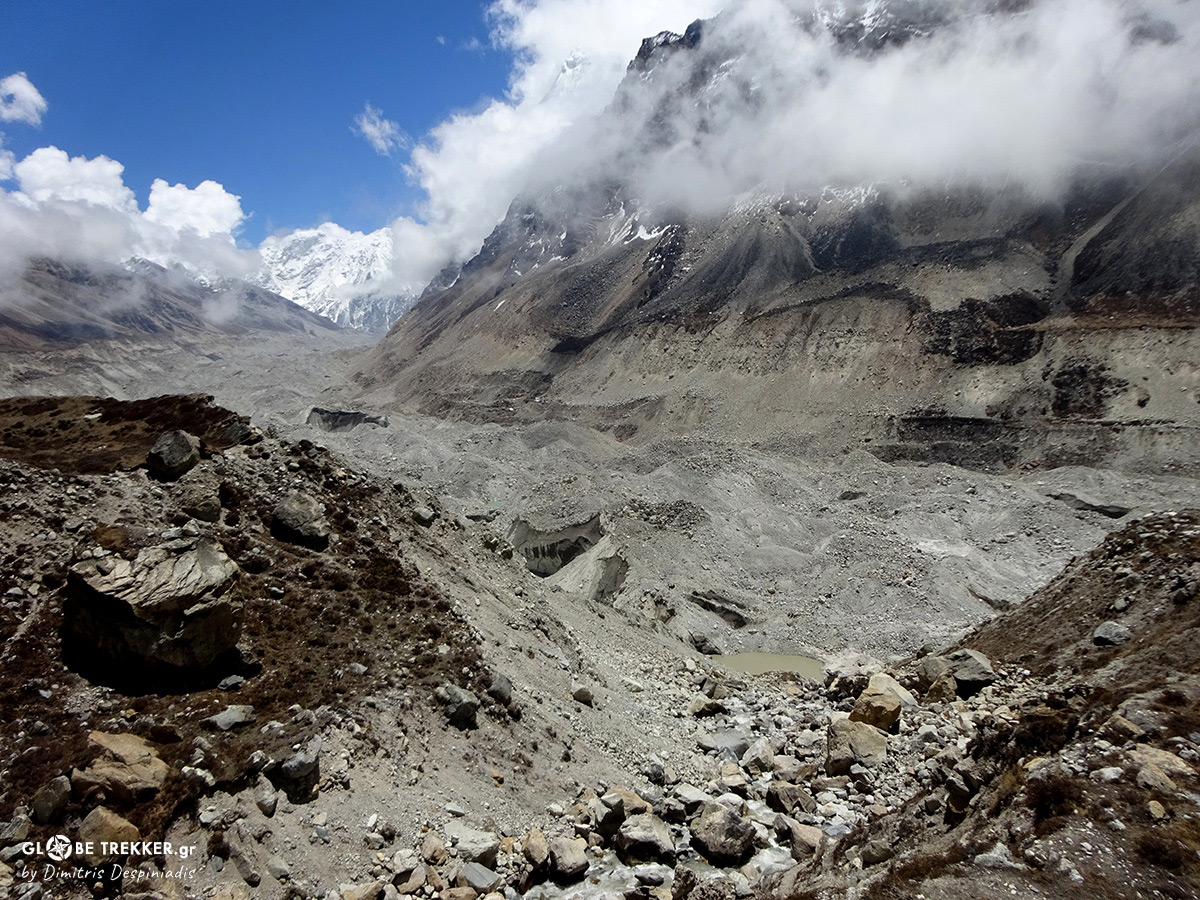
The ambitious solo traverse that I had planned ( connecting the two areas ) ended even before actually starting. On 25/04/2015 – while waiting for my flight to Kathmandu at the transit of Istanbul’s airport – I heard the news about the catastrophic earthquake that had just hit the country, causing thousands of deaths and destroying many of its infrastructures.
A year later, I finally arrived with a different plan ( Kangchenjunga area ) and in the company of Dimitris, a hiking partner in many of my travels.

The approach
Our journey began in the tropical zone ( Terai ), pretty close to the Indian border.
We escaped from Birtamod’s ( 170m ) heat with a local overcrowded bus, in which we were the only foreigners. Eleven ( 11 ) bumpy hours later we arrived in Taplejung ( 1700m ), the district’s headquarters.

While leaving behind its crowded by pilgrims bazaar ( who start from here the 3-day trek to the Hindu Pathibara temple ) , we were aware that for the following weeks the noises of the modern world would be replaced by those of nature !
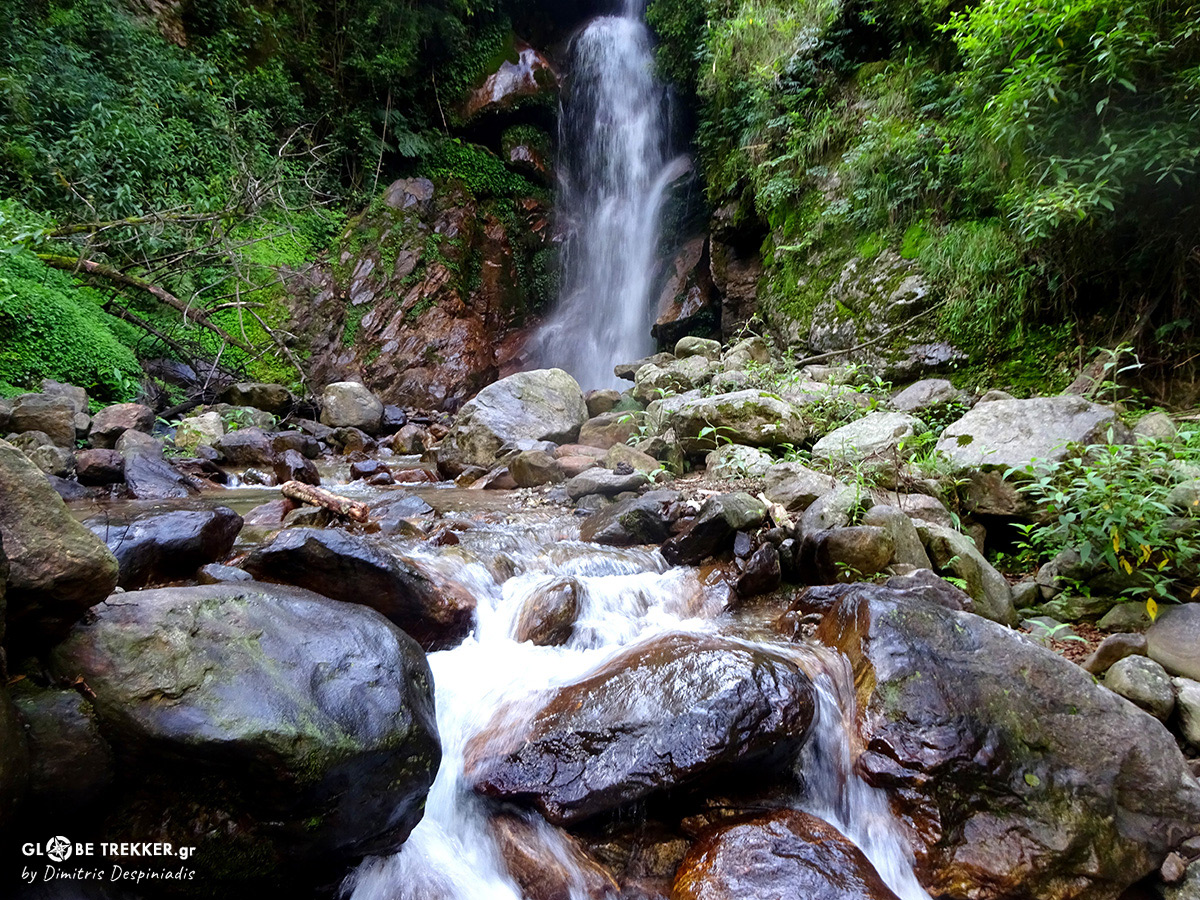
The Subtropics
The first days were long. Considering the low altitude we decided to cover greater distances that would allow us extra days in case of illness or very bad weather.
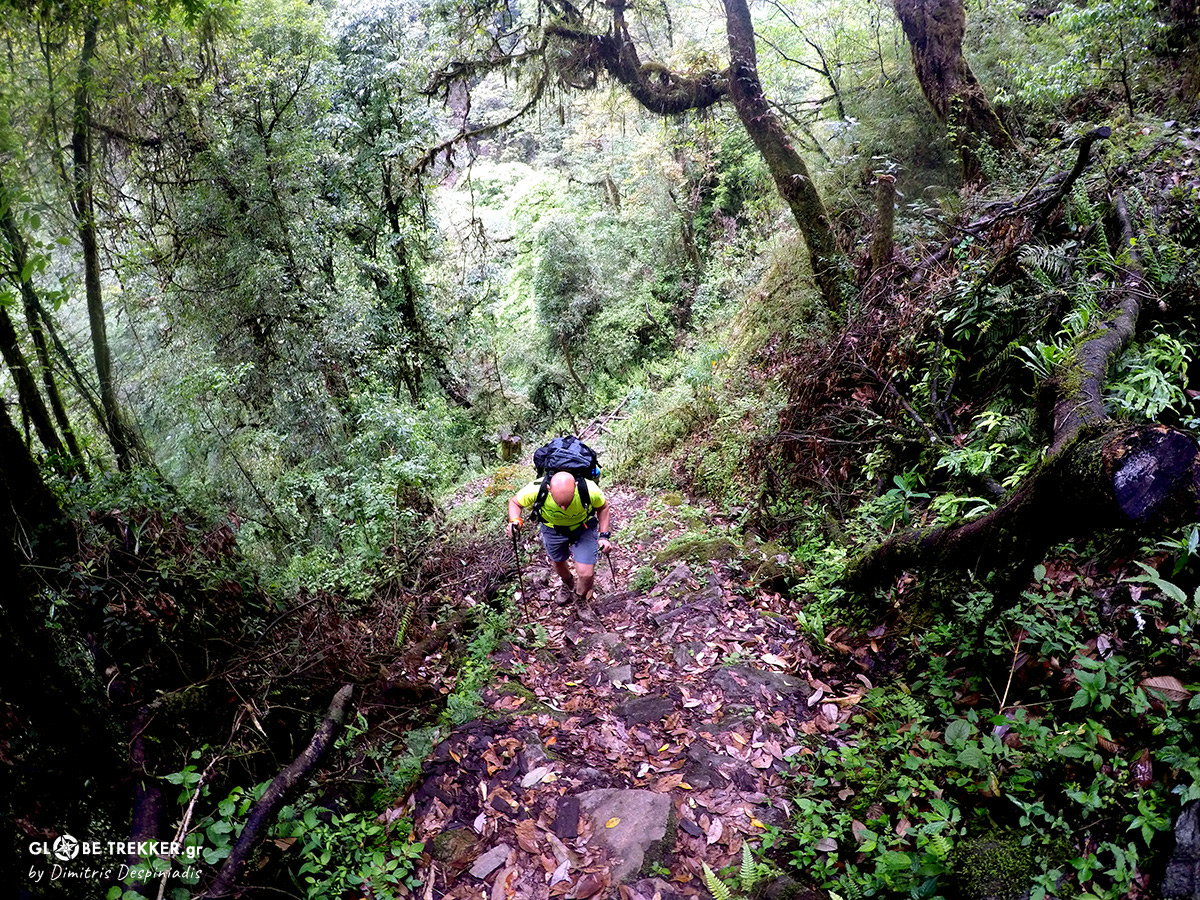
Slippery footpaths led us steeply higher- through ancient subtropical forests – before falling back to the river level. At times we traversed the overgrown slopes of narrow gorges.
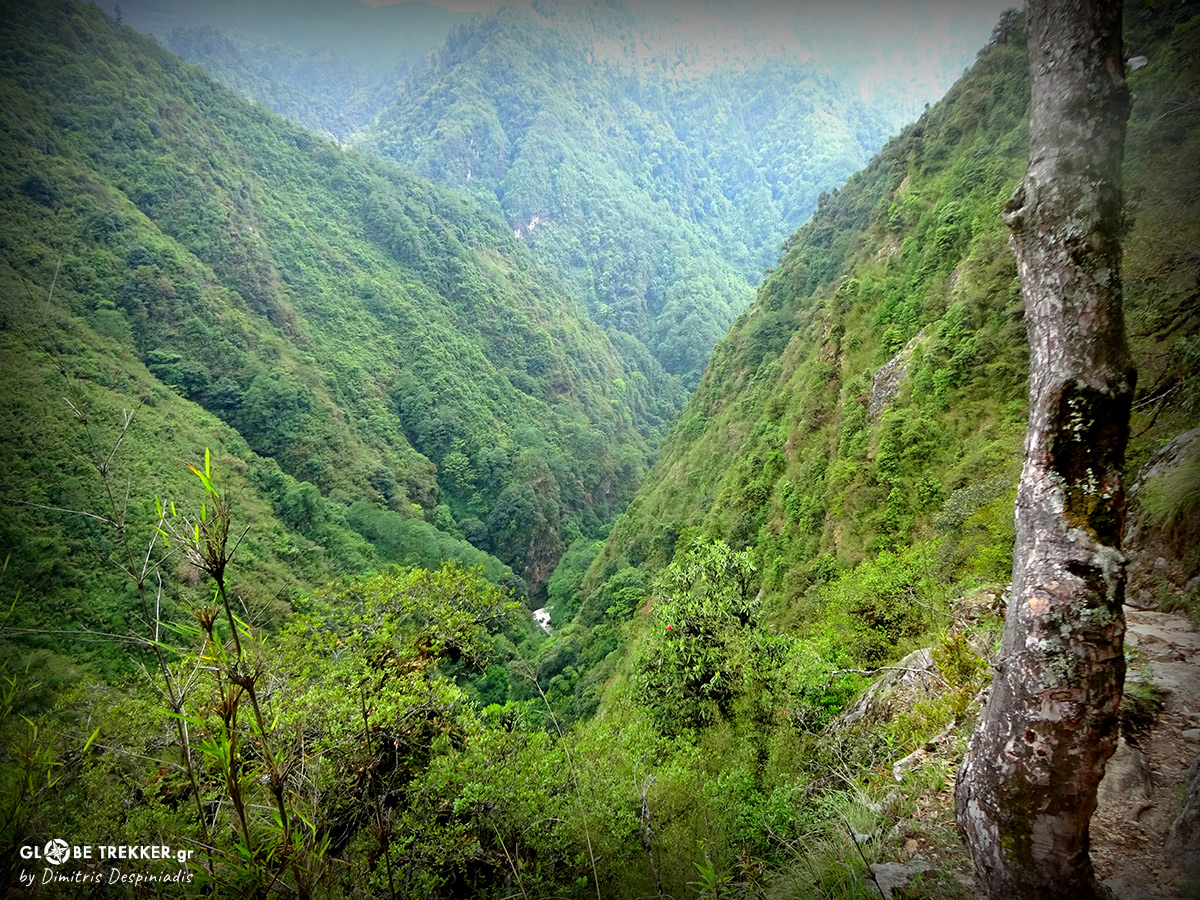
Red cardamon ( elanchai ) is growing here in the shade of huge trees.The villagers have cut some portions of the forest, where they cultivate wheat, corn and more.
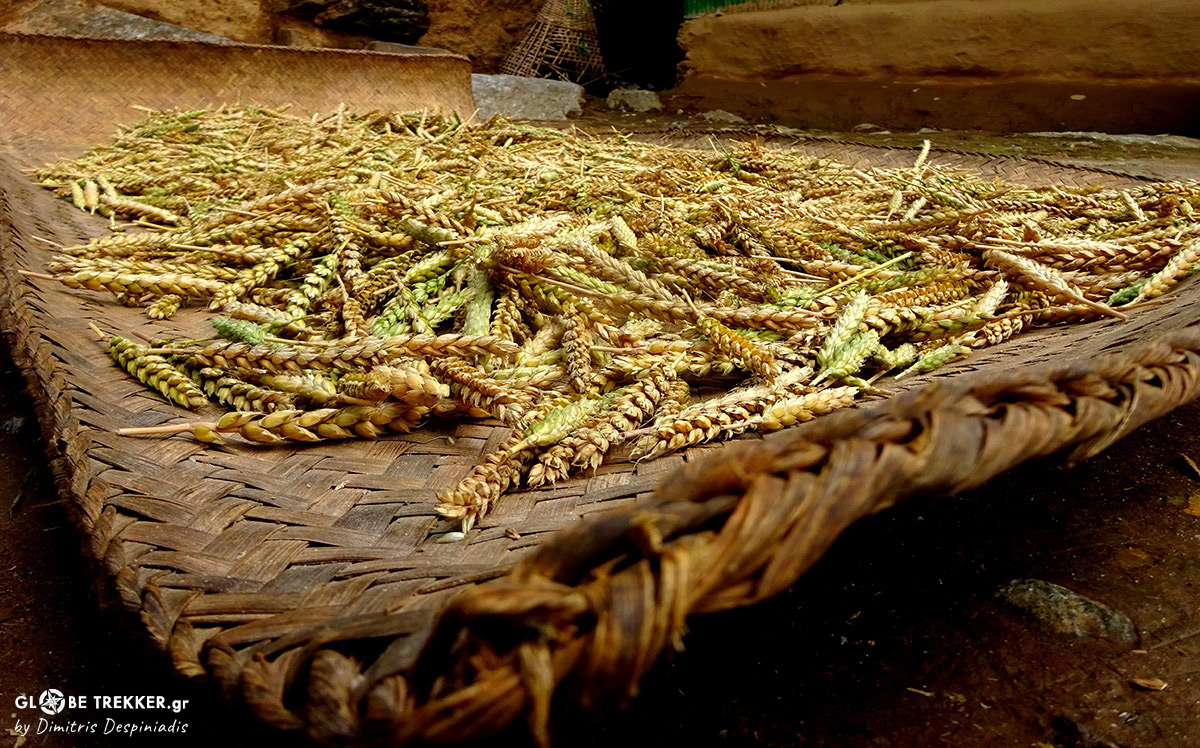
The humid heat and mist that were following the frequent rainfalls were bringing leeches that accompanied us for the first few days. These tiny fellows have the “bad” habit to penetrate to every possible uncovered part of human skin. Most of the times we could not detect them, until a blood stain showed their presence.
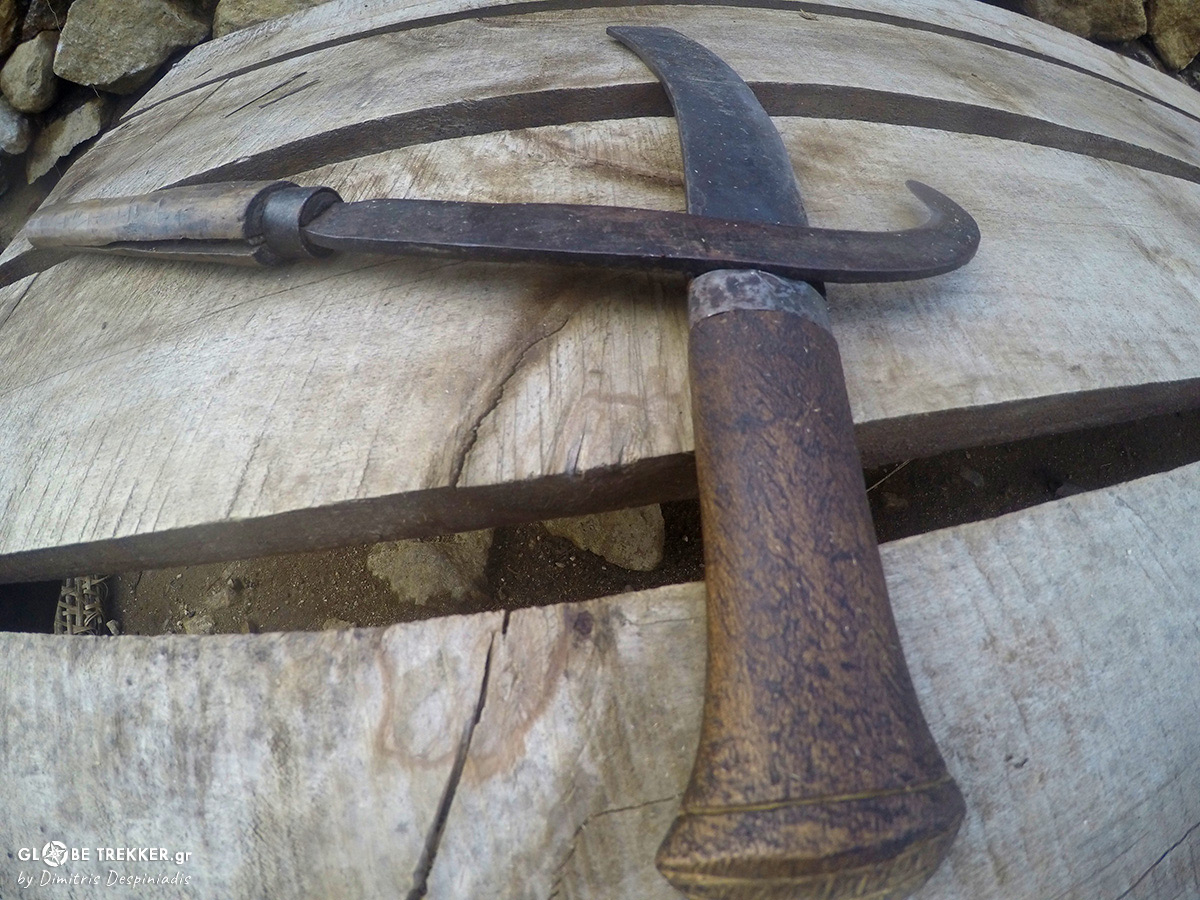
My decision to travel just before the monsoons gave us more possibilities to encounter way less travelers and – indeed – beside the Kiwis we met on day 1, we saw other foreigners a week later!
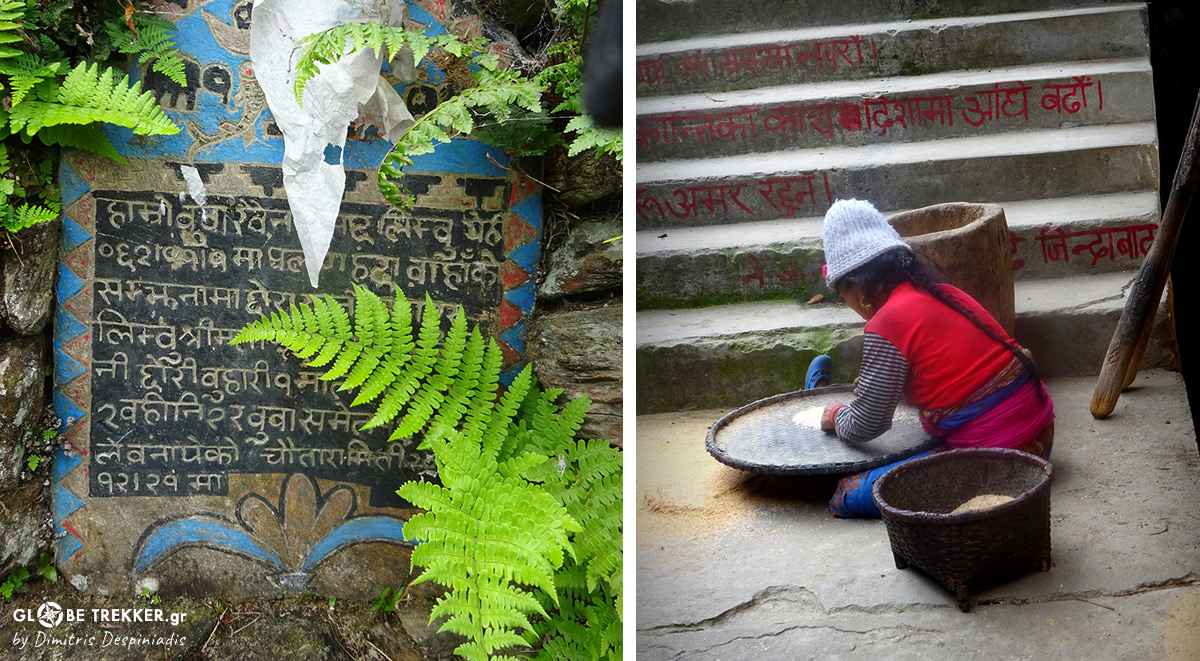
So, the curious looks of the villagers were not a surprise and we had the pleasure to communicate with some of them cordially ! People here are of a broad ethnic background ( Limbu, Rai, Gurung), they drink a lot of rakshi ( local spirit ) and most of them are Hindu.
Every night we were sleeping in brick and wooden houses in tiny villages and every night it rained solidly !
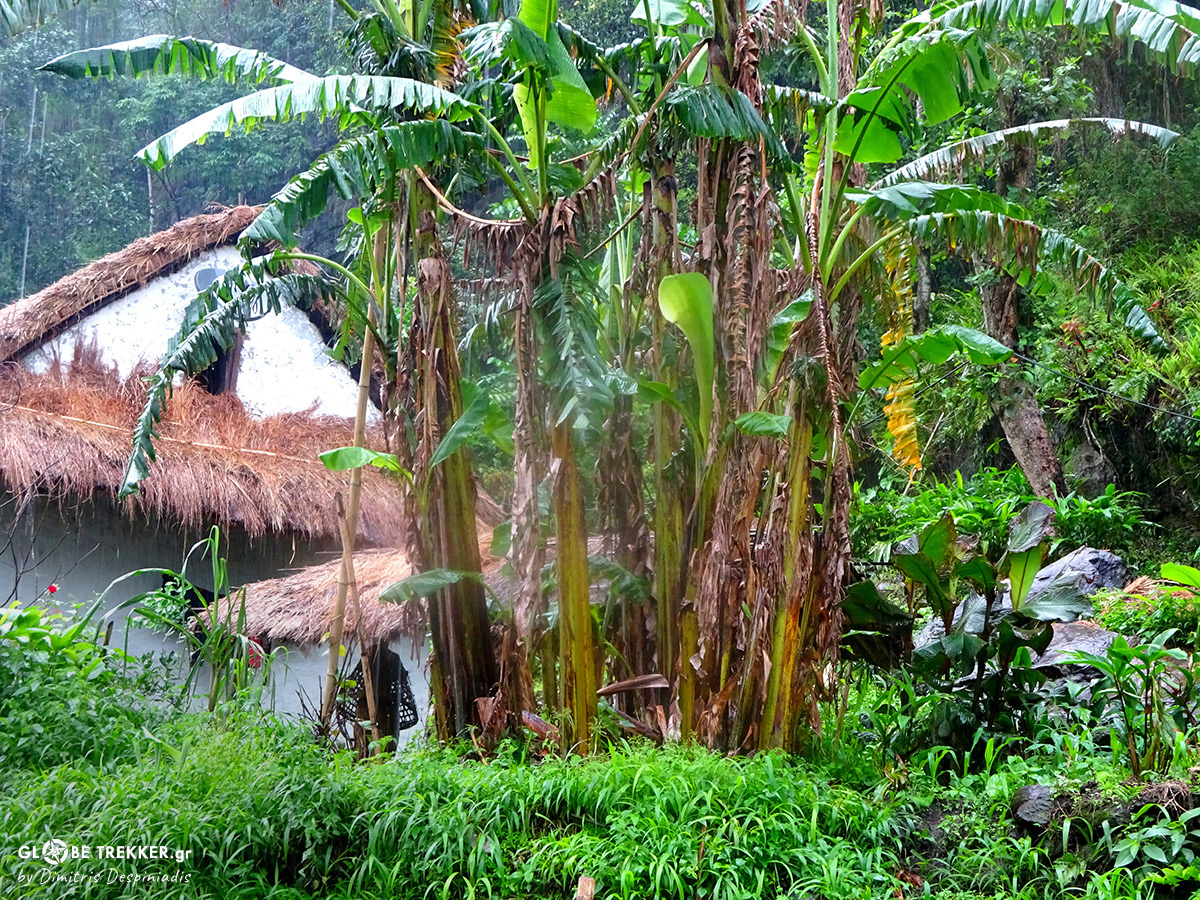
The Temperate forests

Lassi Bhanjyang (3415m).
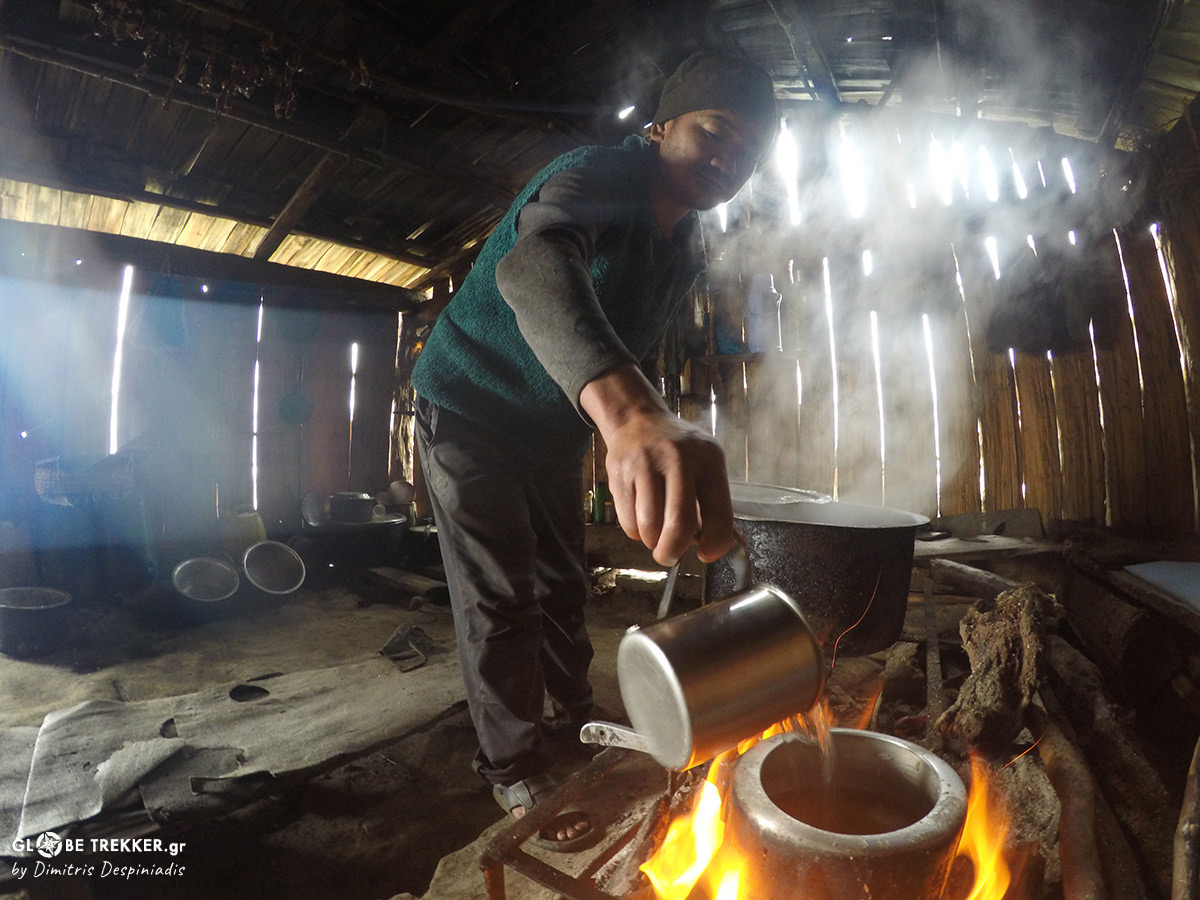
“Dhal ?”
our host asks, ready to pour over with a spoonful of lentils the rice and the few – topped with chili – fried vegetables that are still steaming inside my plate. I thank him but without taking even for a moment my eyes away from the fire. I almost fall asleep.
His primitive hut (Yak Kharka ) is offering us a shelter from the rain.
I can almost tell that he enjoys our presence. As he already told us, he got bored being alone here and he’s eager to take his yak back to Sherpagaon ( the village we spent the previous night ) in a few days.
A steep ascent – through magical temperate forests full of pine trees, oaks, maples, larches and rhododendrons has brought as here. Although we enjoy our stay at the hut, we still have a long way to go. Our wet clothes almost dried by the fire.
“Shall we go Dimitris ?”
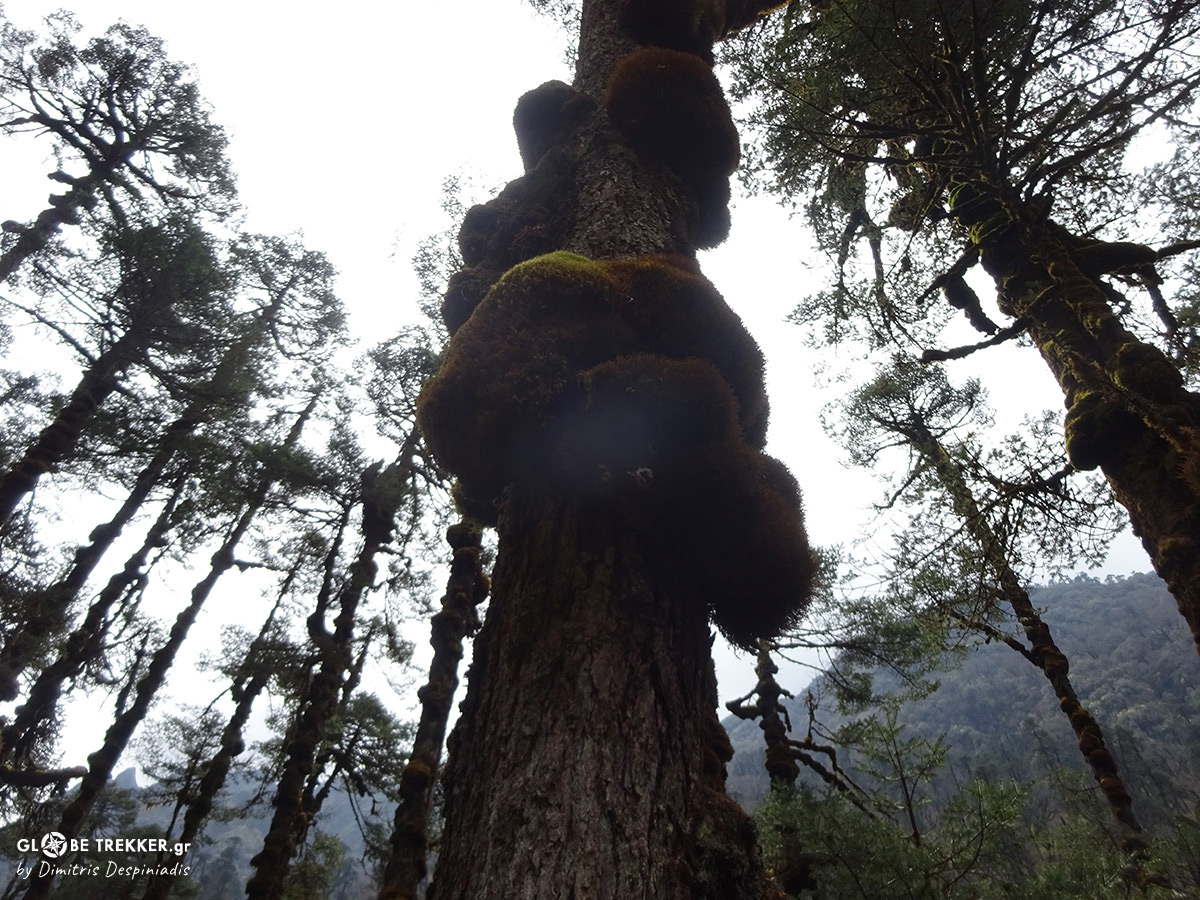
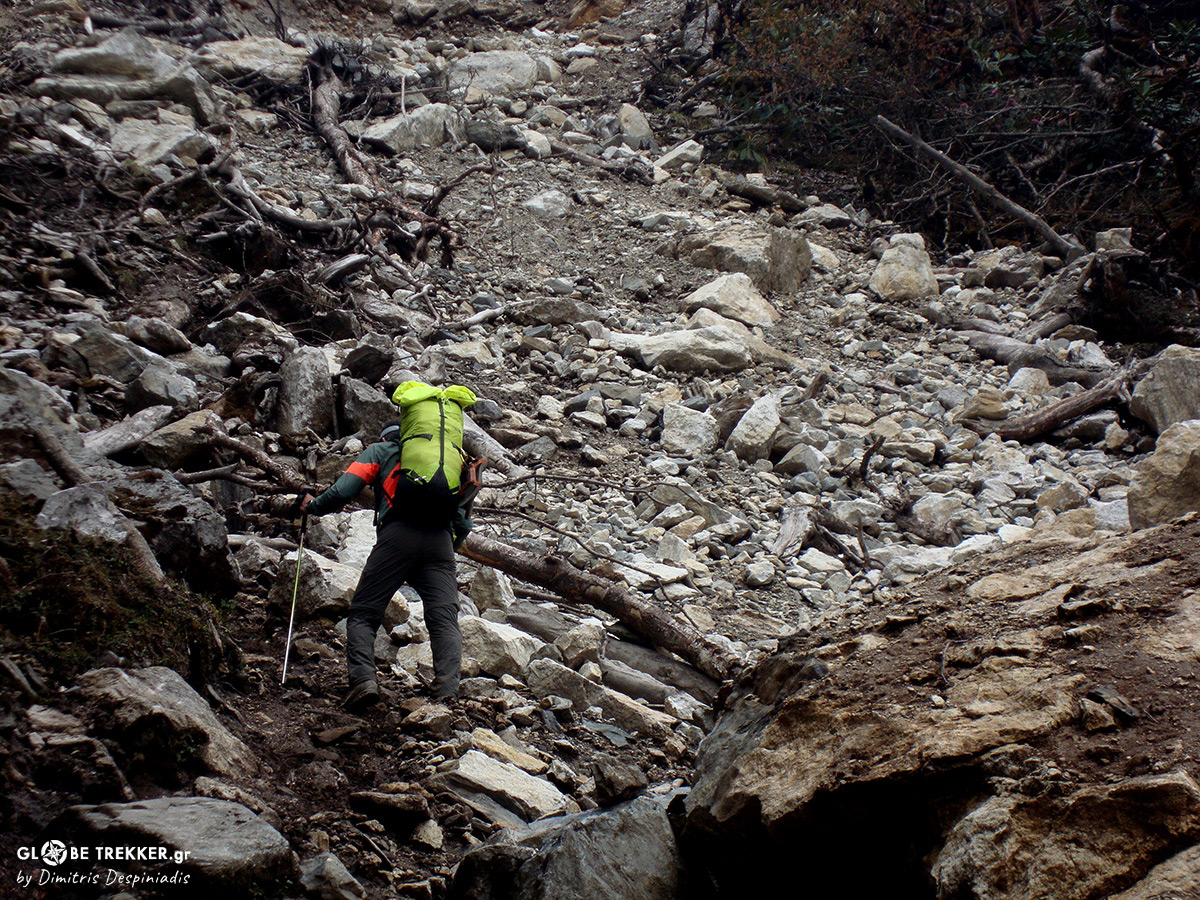
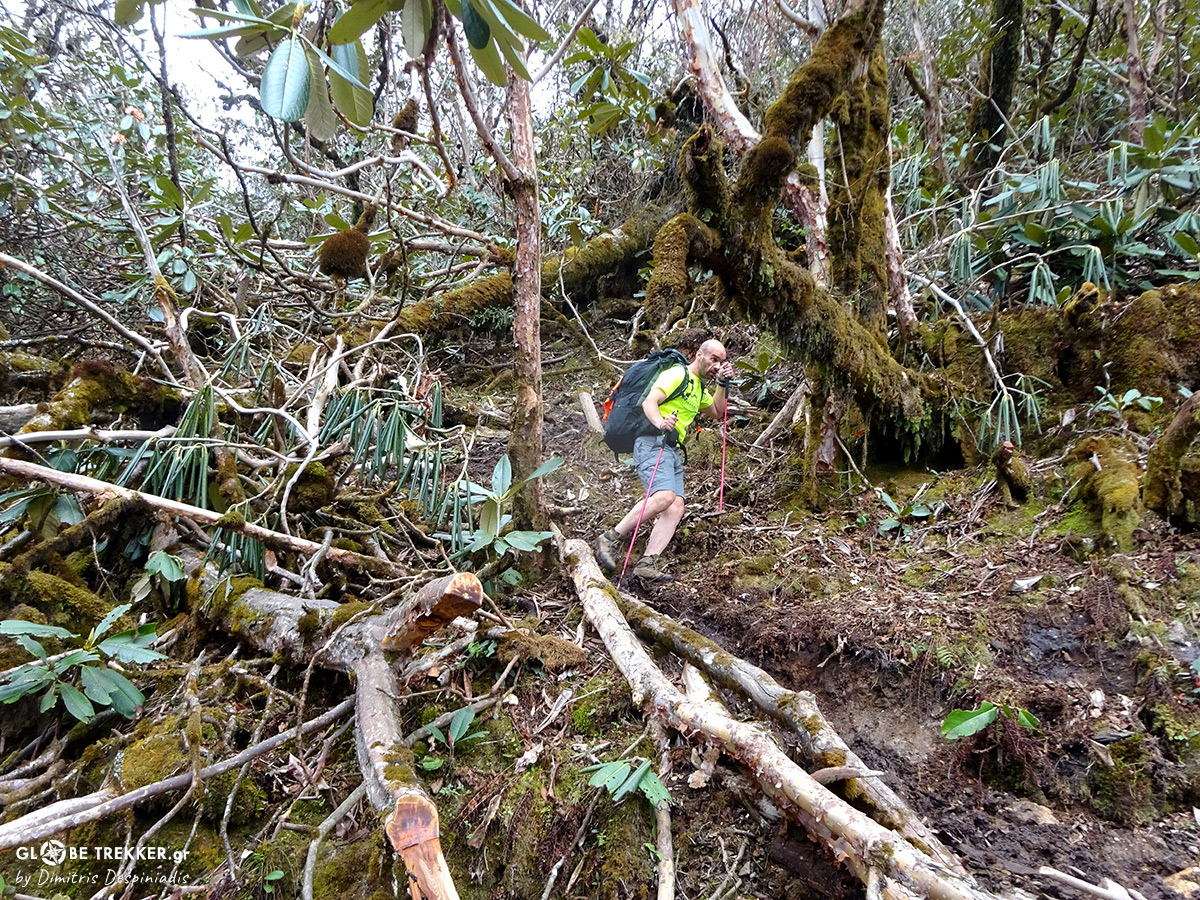
A newly cut path, avoiding a massive landslide, led us to the suspension bridge of Simbuwa khola river. Late in the afternoon, in the midst of an electrical storm we reached Tortong ( 2980m ), consisting of two houses surrounded by beautiful forests where we spent the night.

Wild land
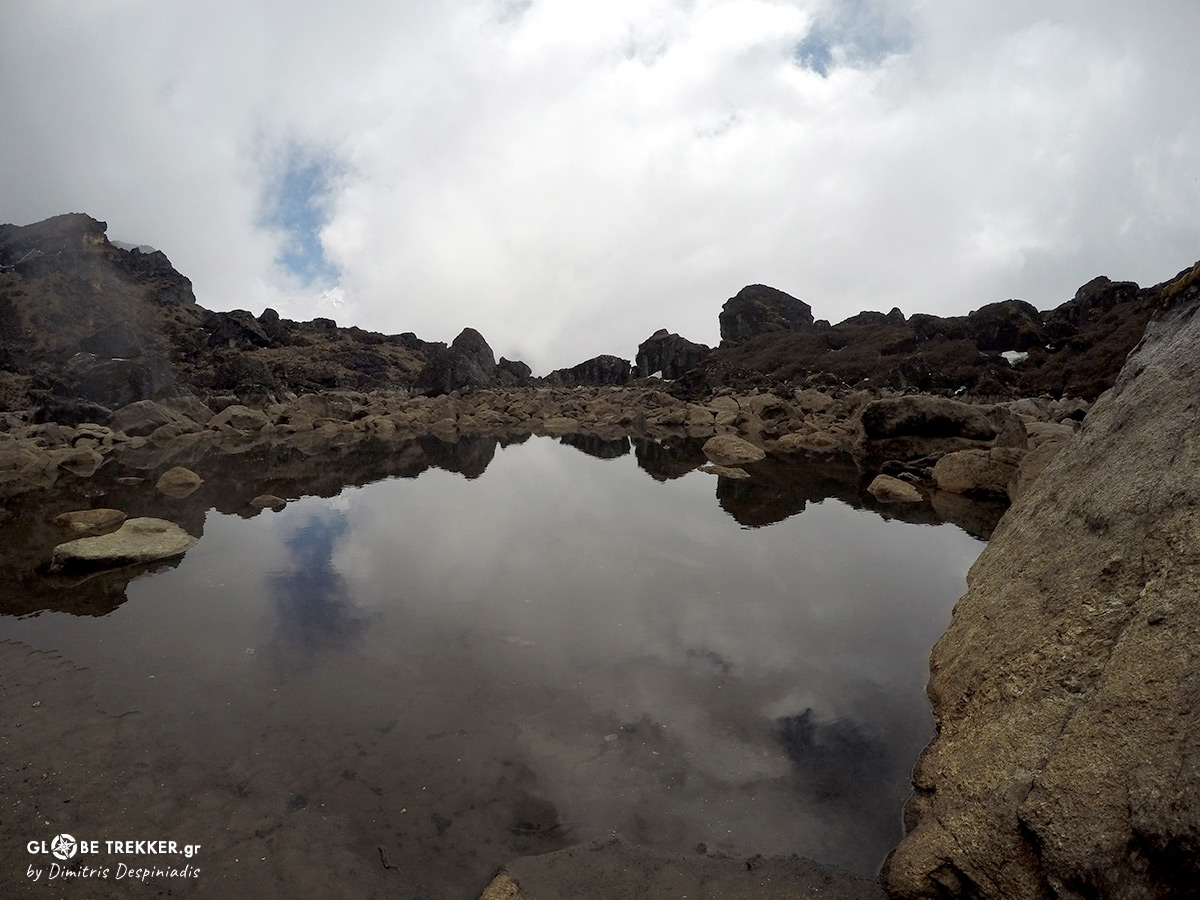

The house of a Sherpa woman in Cheram (3860m ) became our base during our acclimatization. Food, sleep and play with her adorable child filled the remaining hours beside our ascent to Sinelapche La pass.
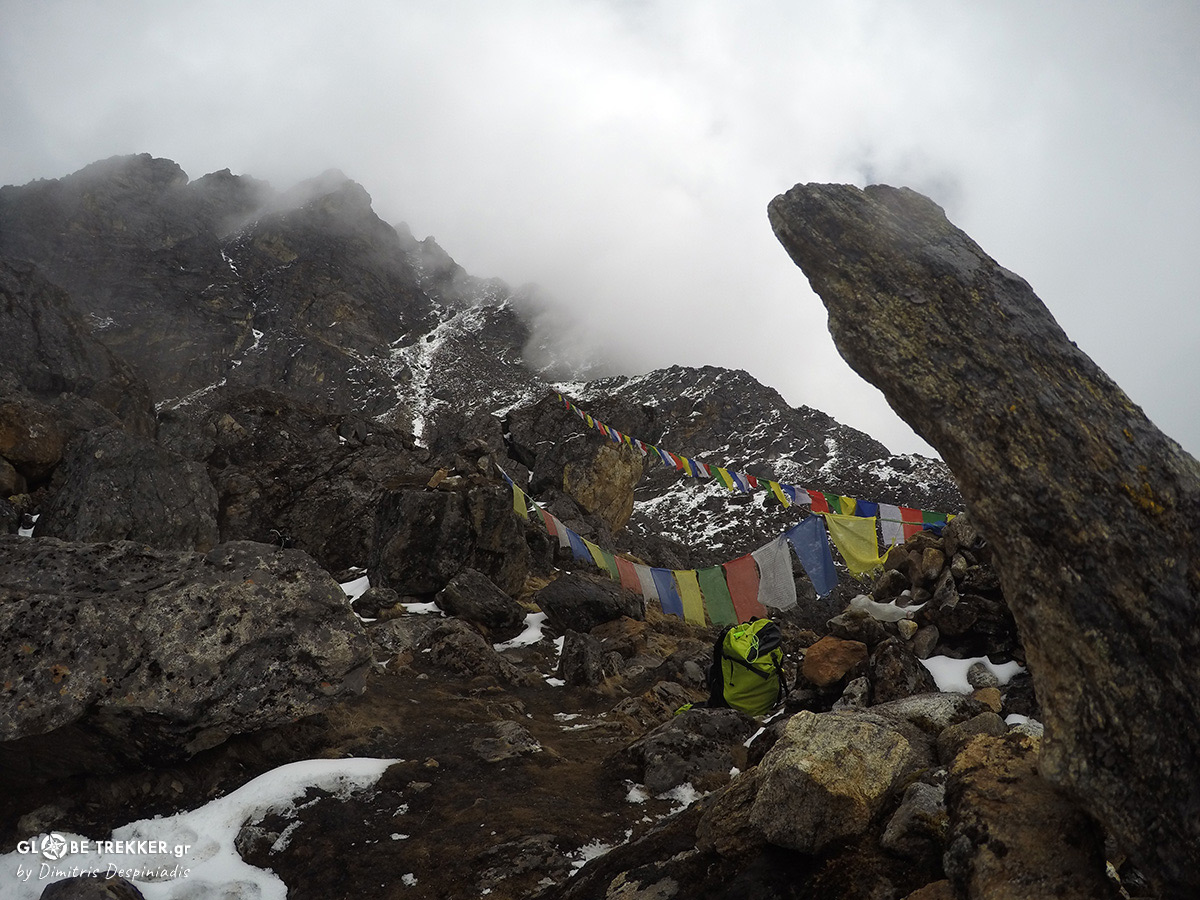
Acclimatization ascent to Sinelapche La (4650m).
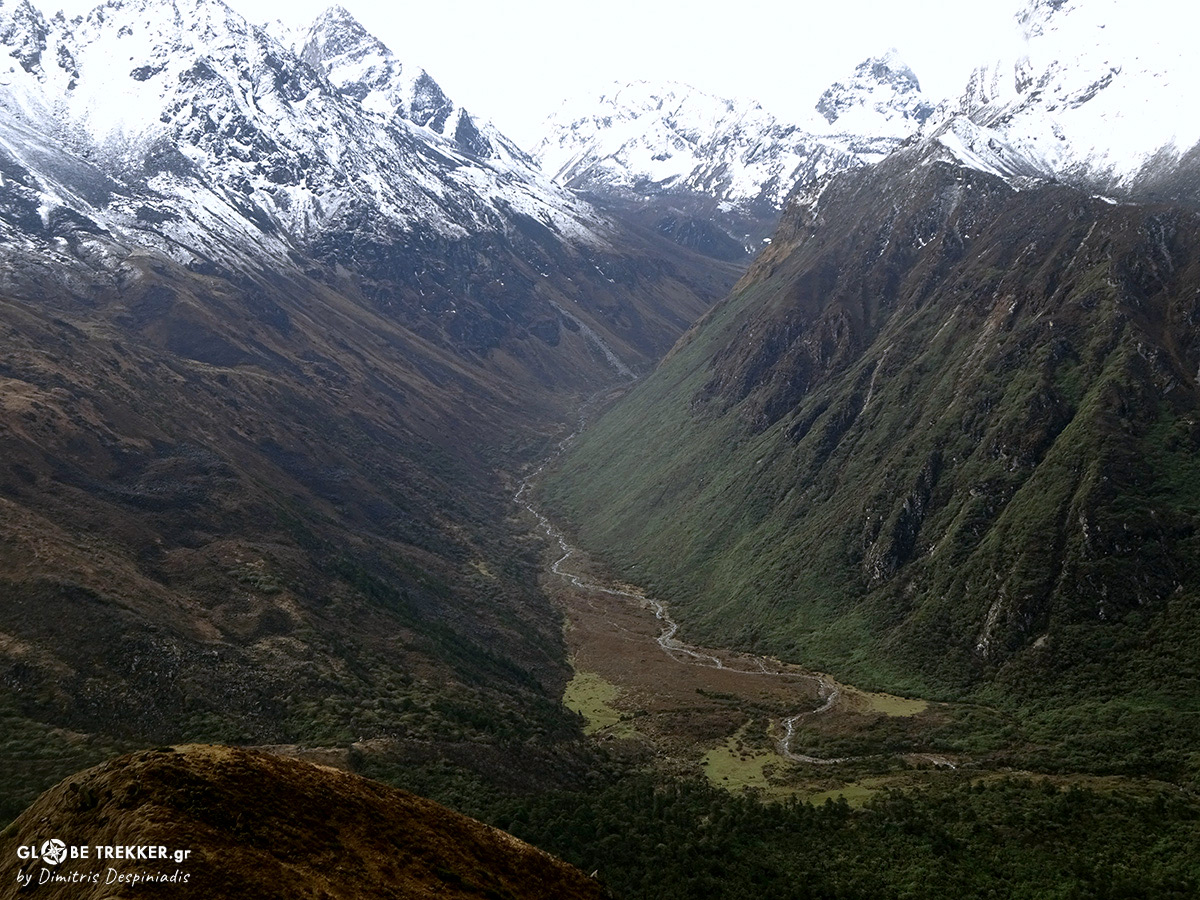
The valley leading to Khang La, a possible entry to Sikkim.
The landscape changed dramatically the last few days ! Thick forests gave way first to subalpine vegetation – with rhododendron bushes and wild flowers in full bloom – and finally to the alpine zone with its rugged terrain. The air became colder and thinner, temperature dropped significantly and the horizons opened ! The skies cleared above 4200m and dramatic views of Rathong and the Kabru group accompanied our hike.
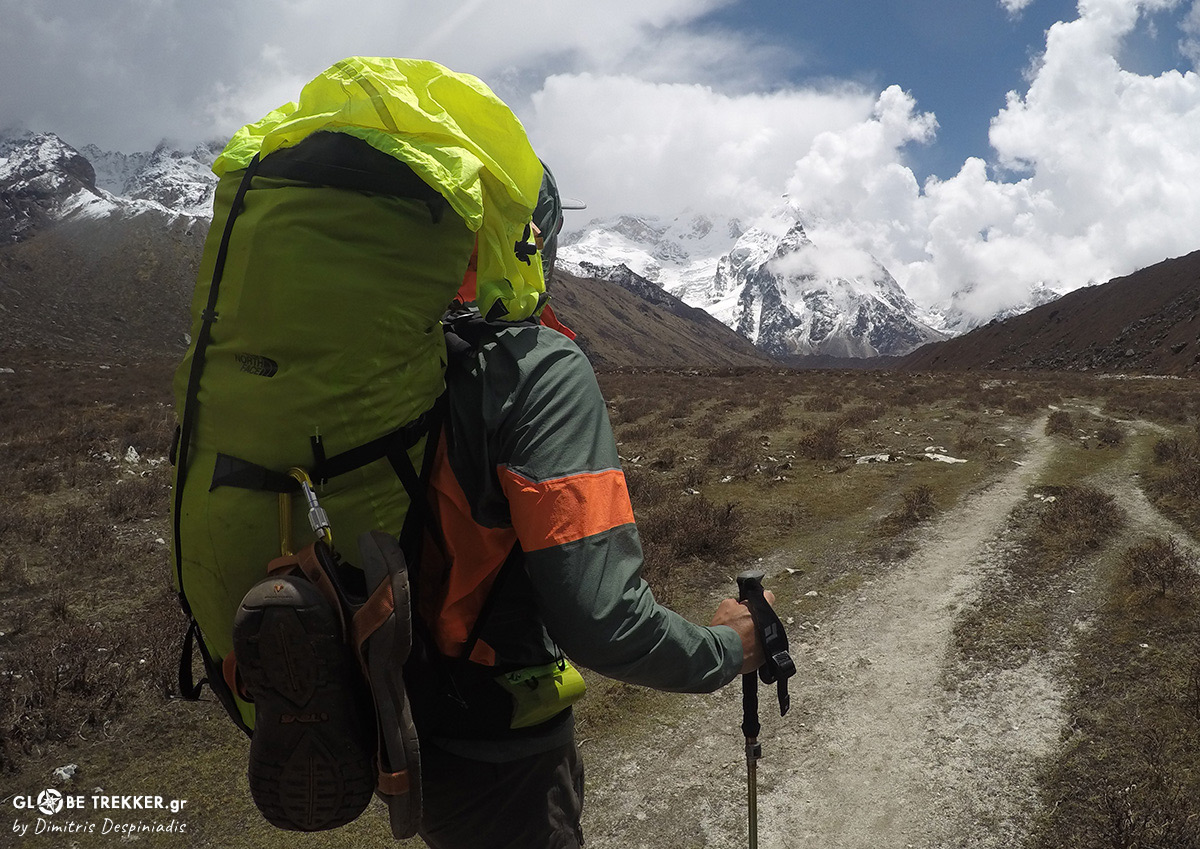
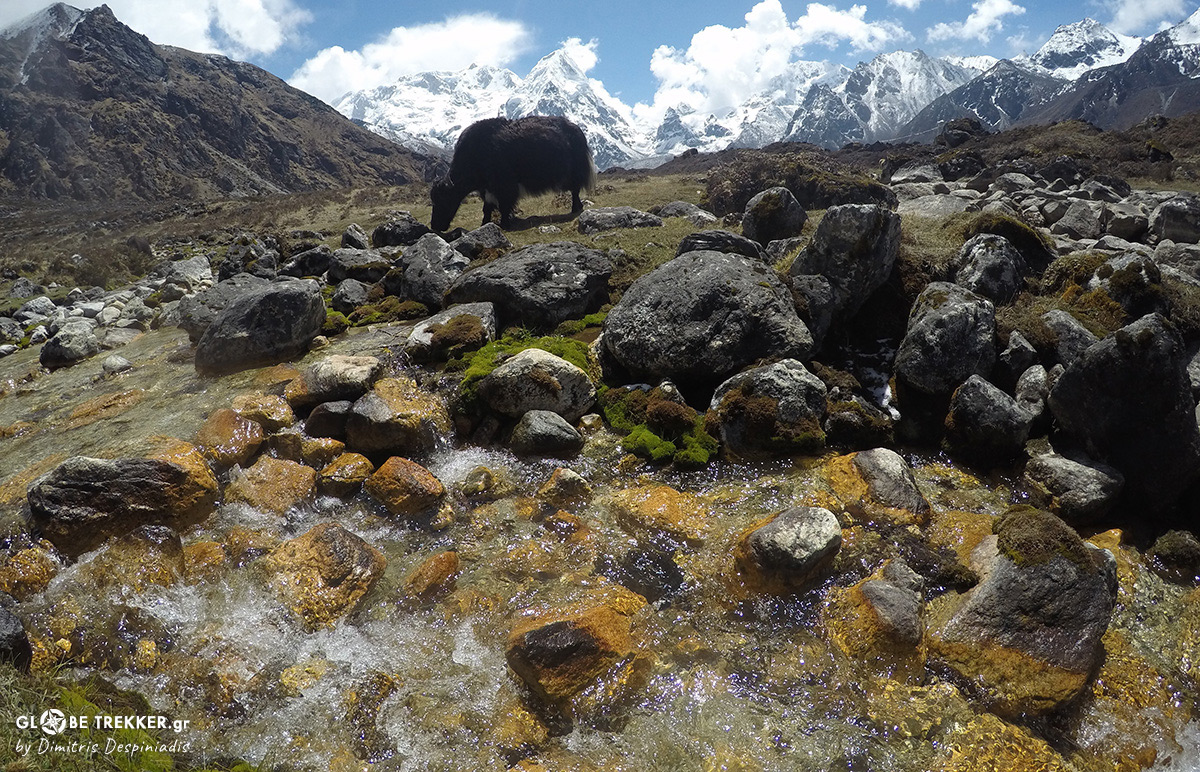
Ramchaur (4610m)
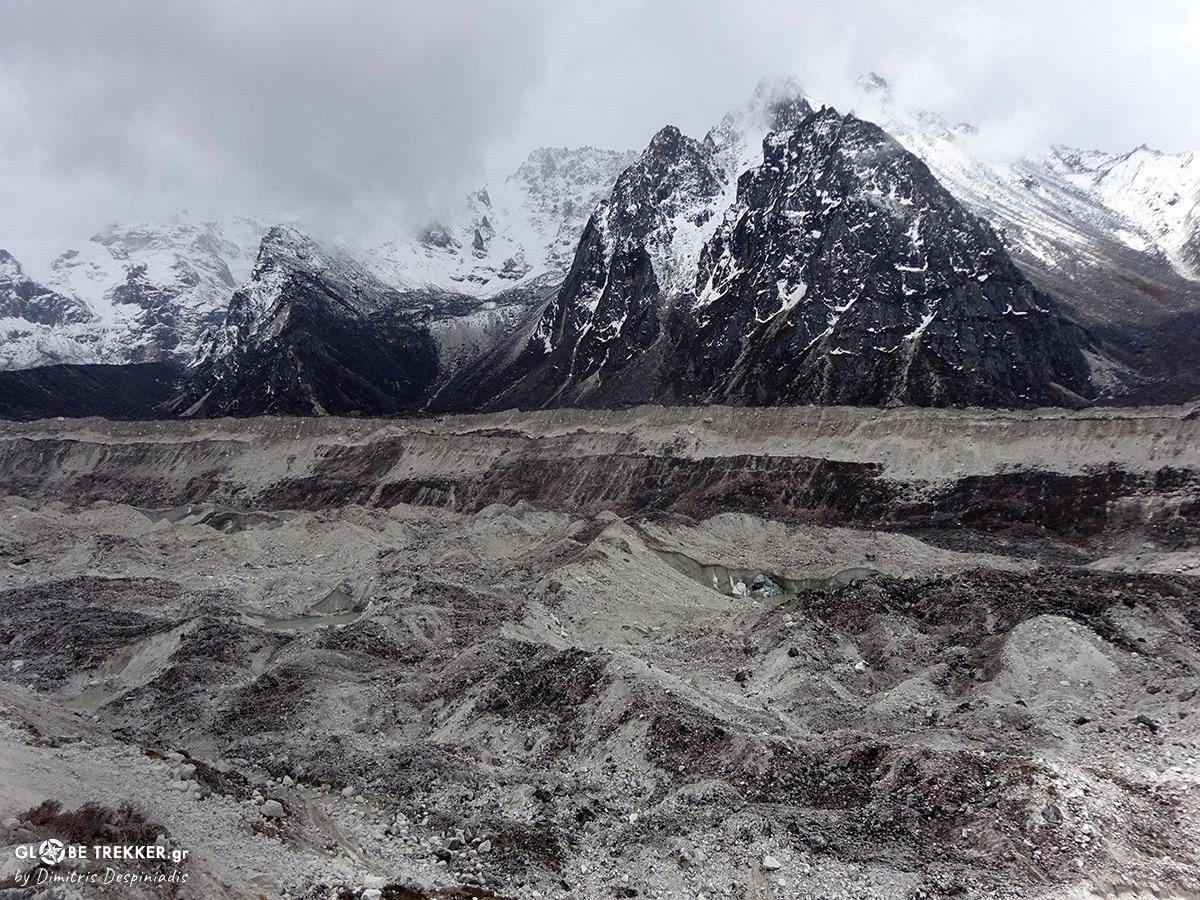
Yalung glacier !
Sitting alone on the moraine wall of Yalung – one of the dozens of glaciers that surround Kangchenjunga and its satellite peaks – I feel a world apart from civilization . I observe in awe ! Cracking sounds interrupt once in a while the otherworldly silence. Rocks fall from the steep slopes above and are added to this massive river of ice and sediment .
“How far back in time this procedure started ? What is mankind compared to the forces of nature and how insignificant – really – is our passage from Earth ?”

A white cloud covered everything and I returned to our – insulated with dung – hut to find Dimitris and our Tibetan host, the only human souls there. I was offered a cup of hot salty tea, then another one until night came, cold took over and we crawled to our sleeping bags, feeling more than grateful !
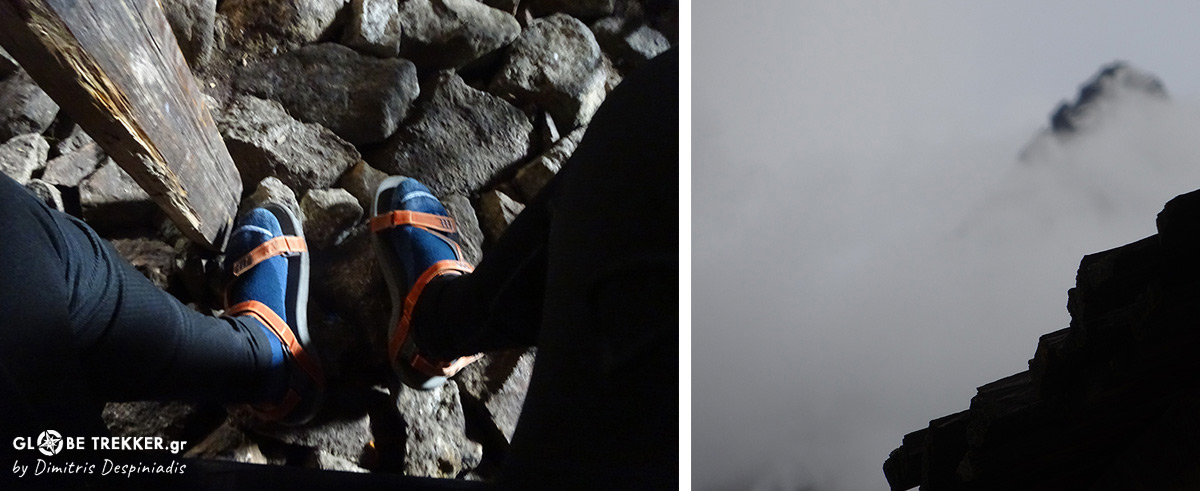
Our march to Okhordung ( 4740m ) – a mass of stones topped with symbols of Hindu ( Shiva tridents ) and Buddhist ( prayer flags ) worship – was blessed with clear skies !
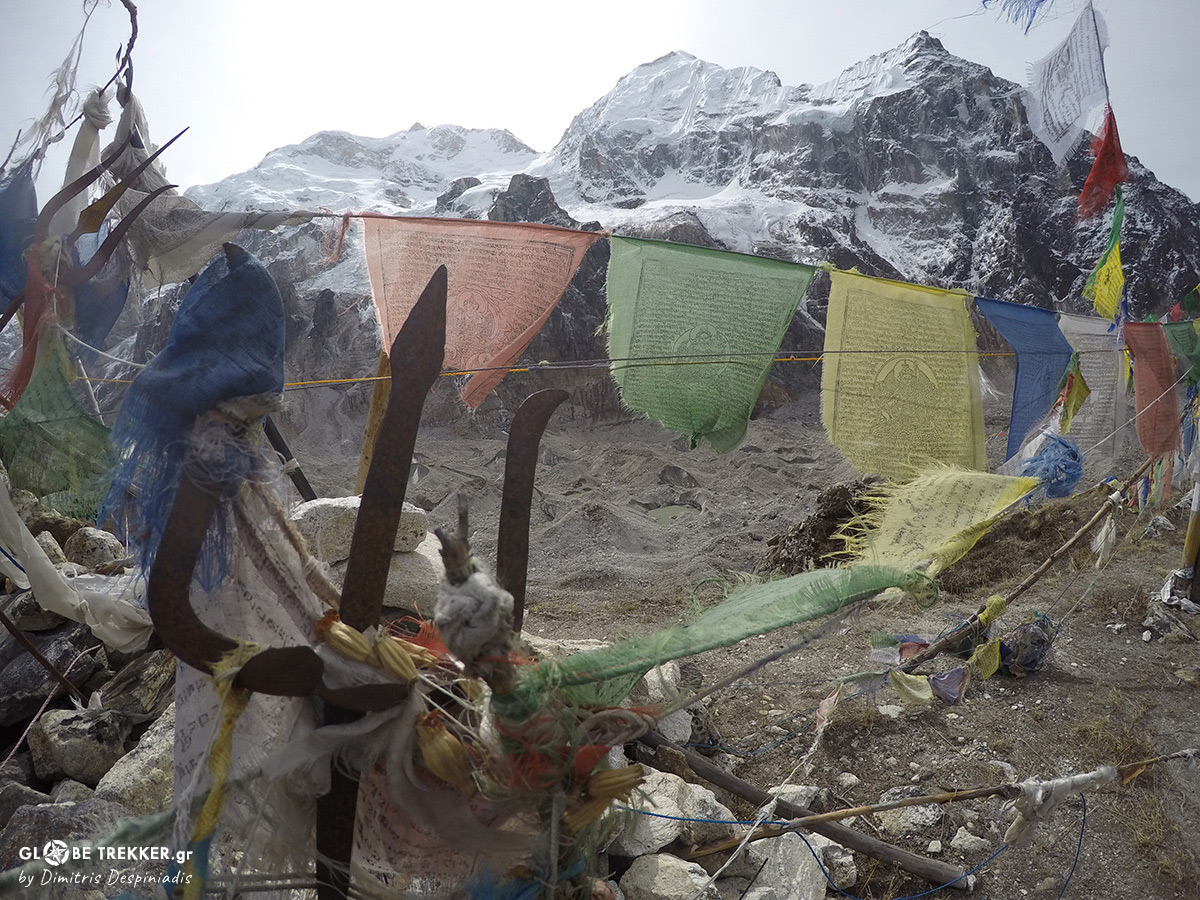
But next day was a whole different story ! Snow and heavy rain accompanied us for the majority of the long “airy” traverse ( through 3 high passes ) to the north ! Visibility decreased dramatically, making navigation difficult and depriving us views of Makalu and Chamlang’s long ridge.
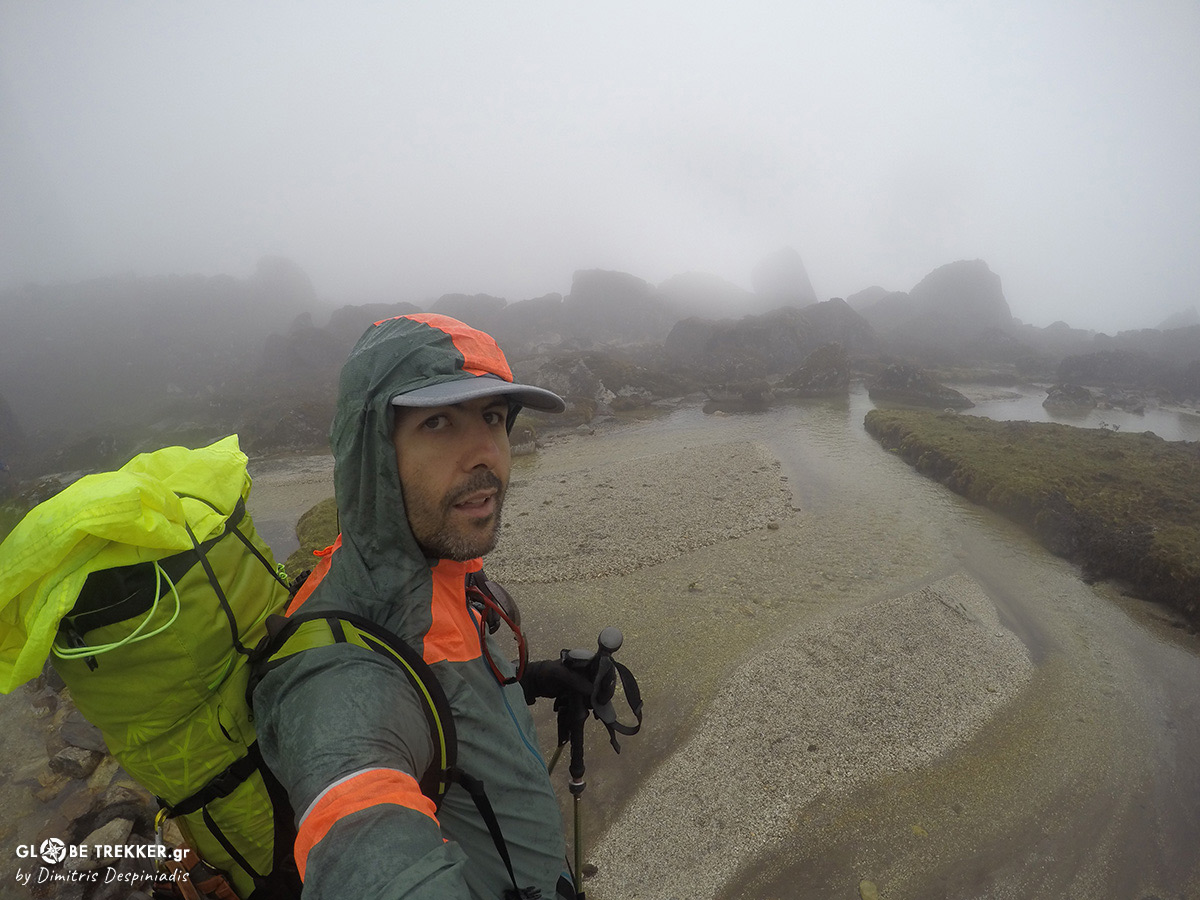
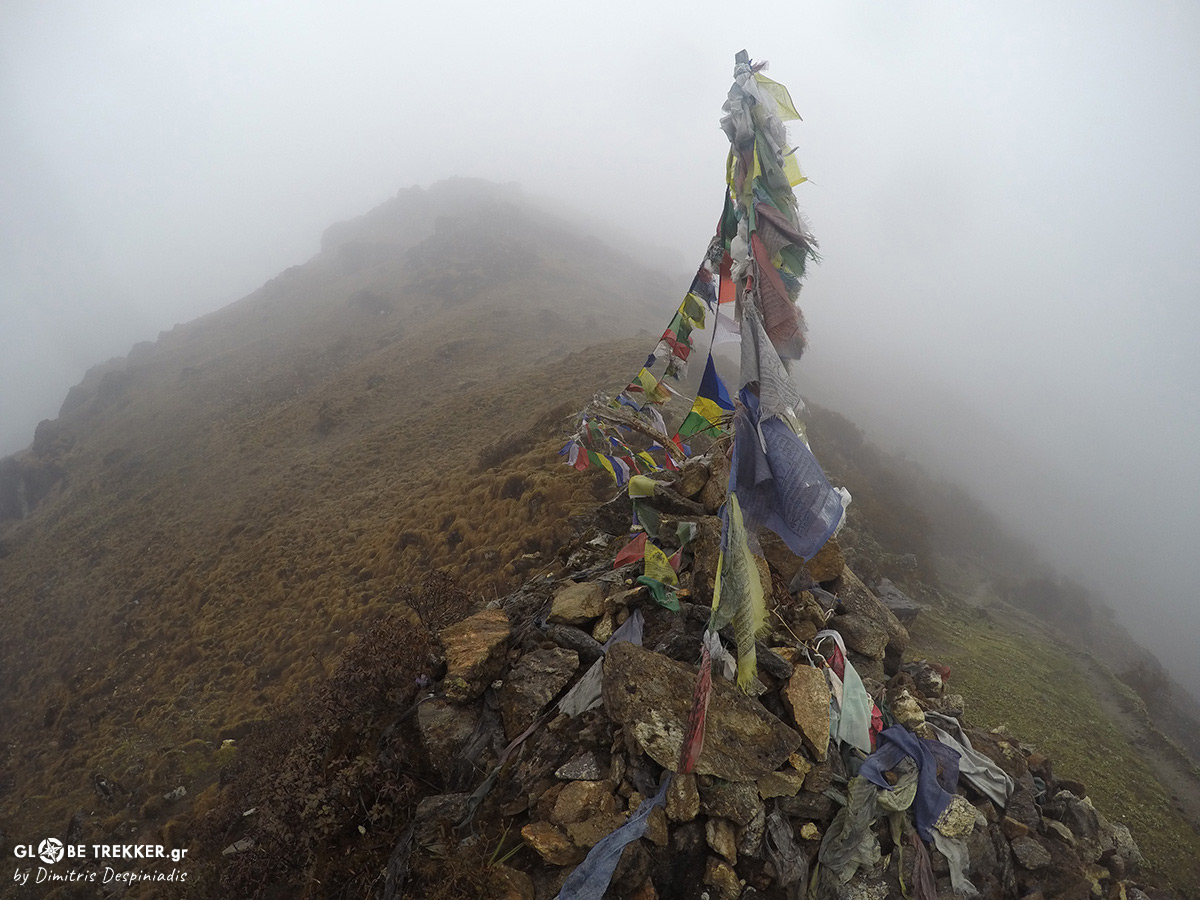
Selele La (4200μ)
The Tibetan Village
Later the same afternoon, I passed the high columns with prayer flags that mark the entrance of Ghunsa ( 3415m ) , the only sizable village ( 20-30 houses ) of our trek, circled by beautiful forests and dramatic cliffs. Dogs, yaks and chickens wandered on the streets.
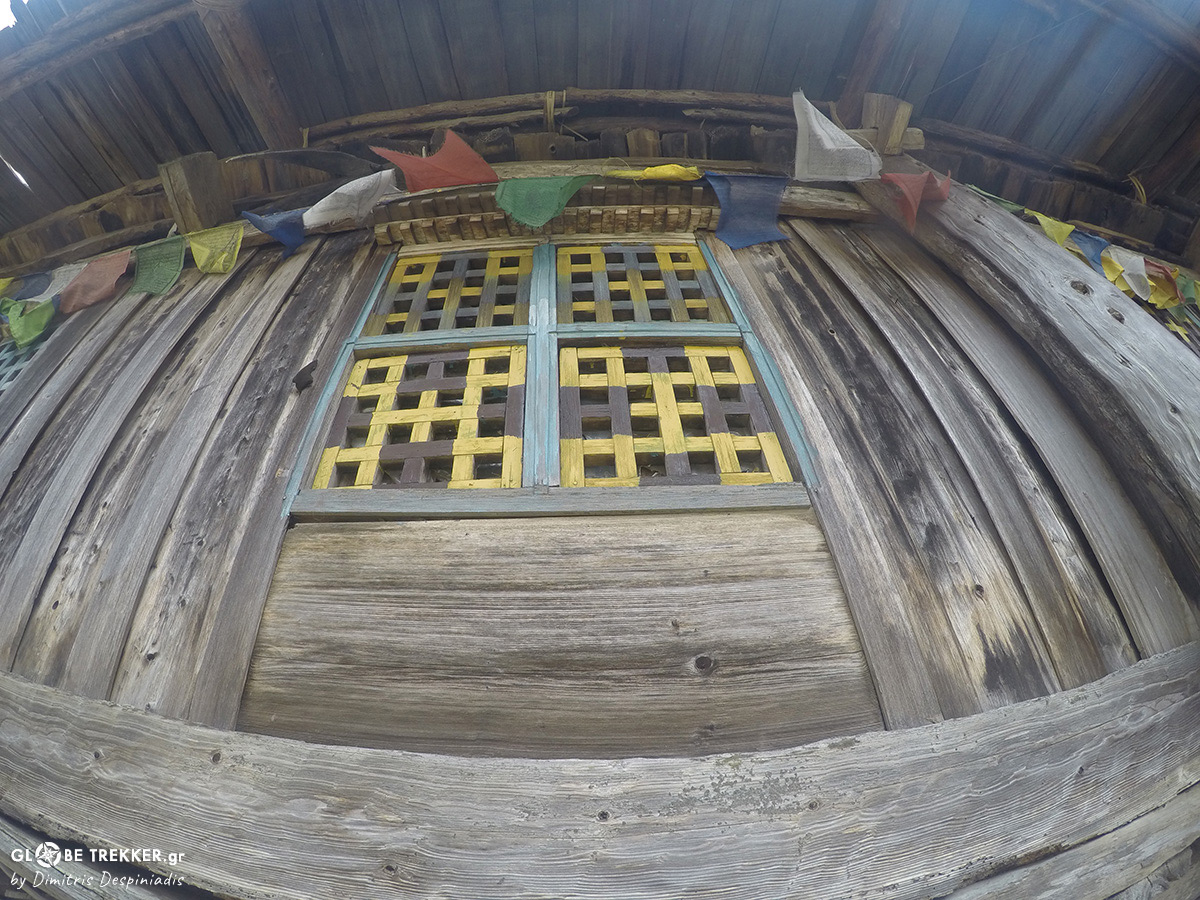
The few people who live seasonally at this altitude and even higher are of Tibetan origin. Sherpas and Bhotes ( whose ancestors migrated from the Tibetan plateau 300 years ago ) and Tibetan refugees ( who found refuge here after the invasion of the Chinese ) !
In our lodge ( ! ) we met the members of a scientific group of WWF ( an American and 4 Nepalese ) that were coming from the northern border via Nango La ( 4795m ) and were heading to where we came from.
After informing them about the conditions we encountered, they presented briefly to us the scope of their expedition that was no other than the Snow Leopard, one of the most rare and endangered big cats found on Earth !
“ During our march we install thermal cameras in caves and remote passes – that can record for about 2 months – and by these we hope to collect informations about their behavior, how they hunt and breed etc , something almost impossible with a bare eye ! ”
“ In my mind Snow Leopards are so rare that are almost mythical creatures !” I replied, remembering how much I was impressed by the famous scenes of BBC’s “Planet Earth” documentary, that were the first to record on camera their behavior in the wild !
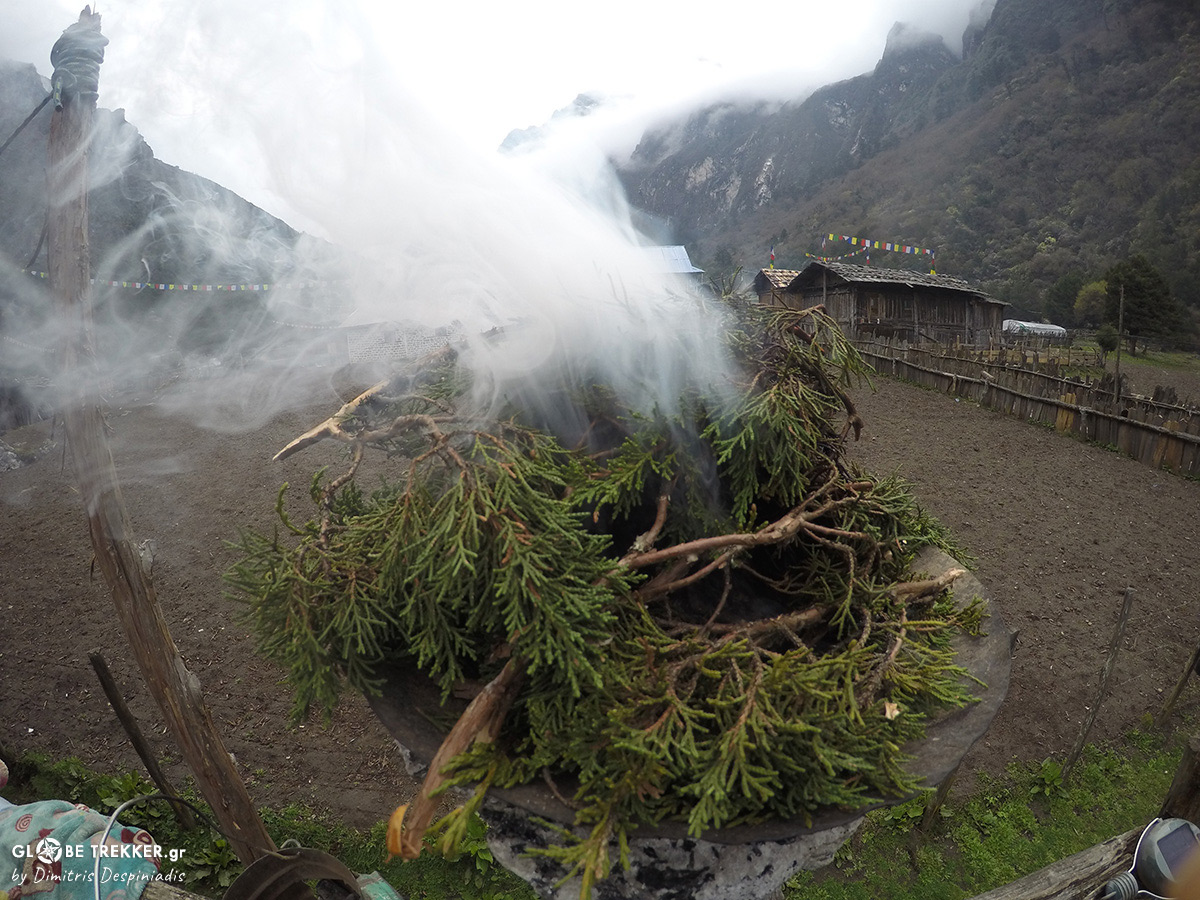
The next morning juniper was burning outside the wooden Tibetan houses with the flat roofs, while the air smelled like Ganja ! While we were putting on our backpacks we saw the full extent of the WWF expedition , with some 20 more guides and porters !
The Giants
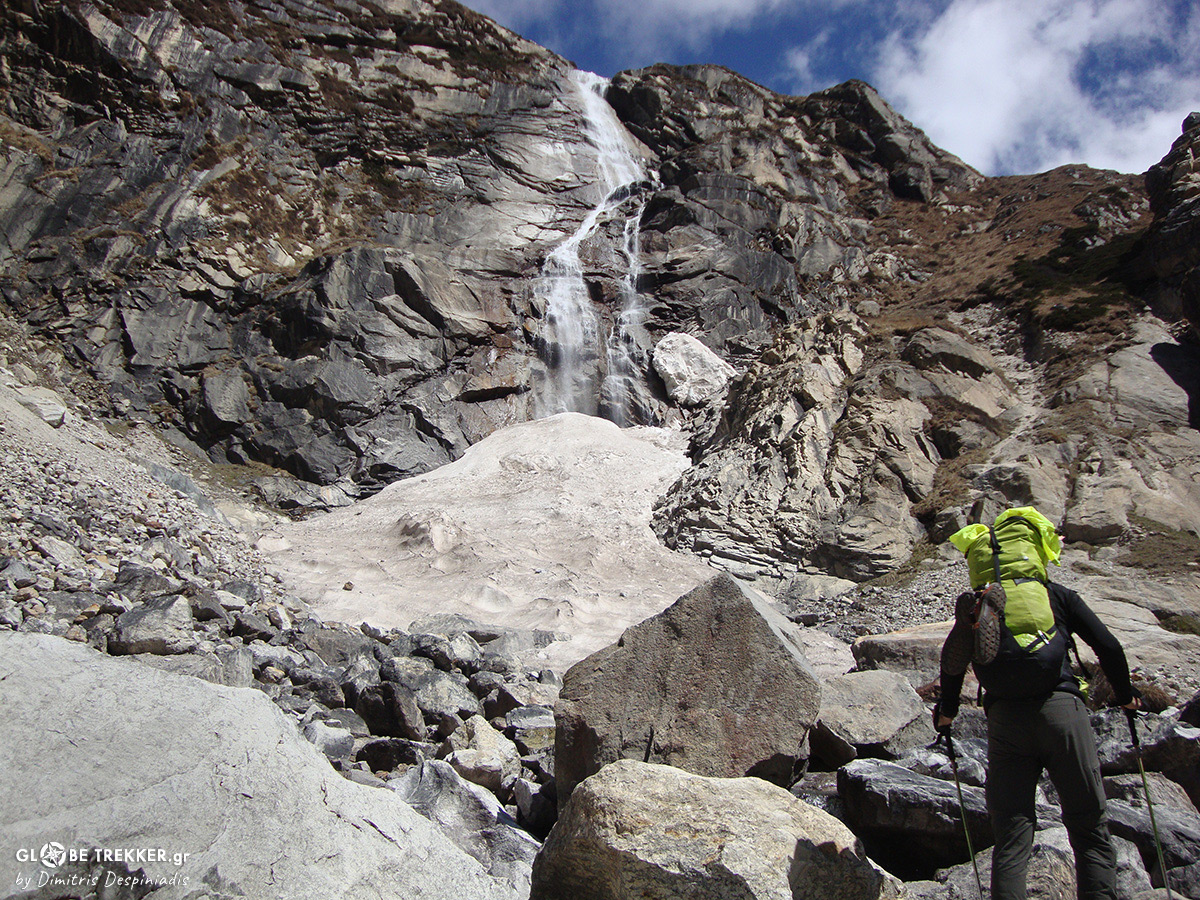
Well acclimatized by now, we left once more the rhododendron forests and waterfalls and proceeded higher – through landslide zones – in a NE direction !
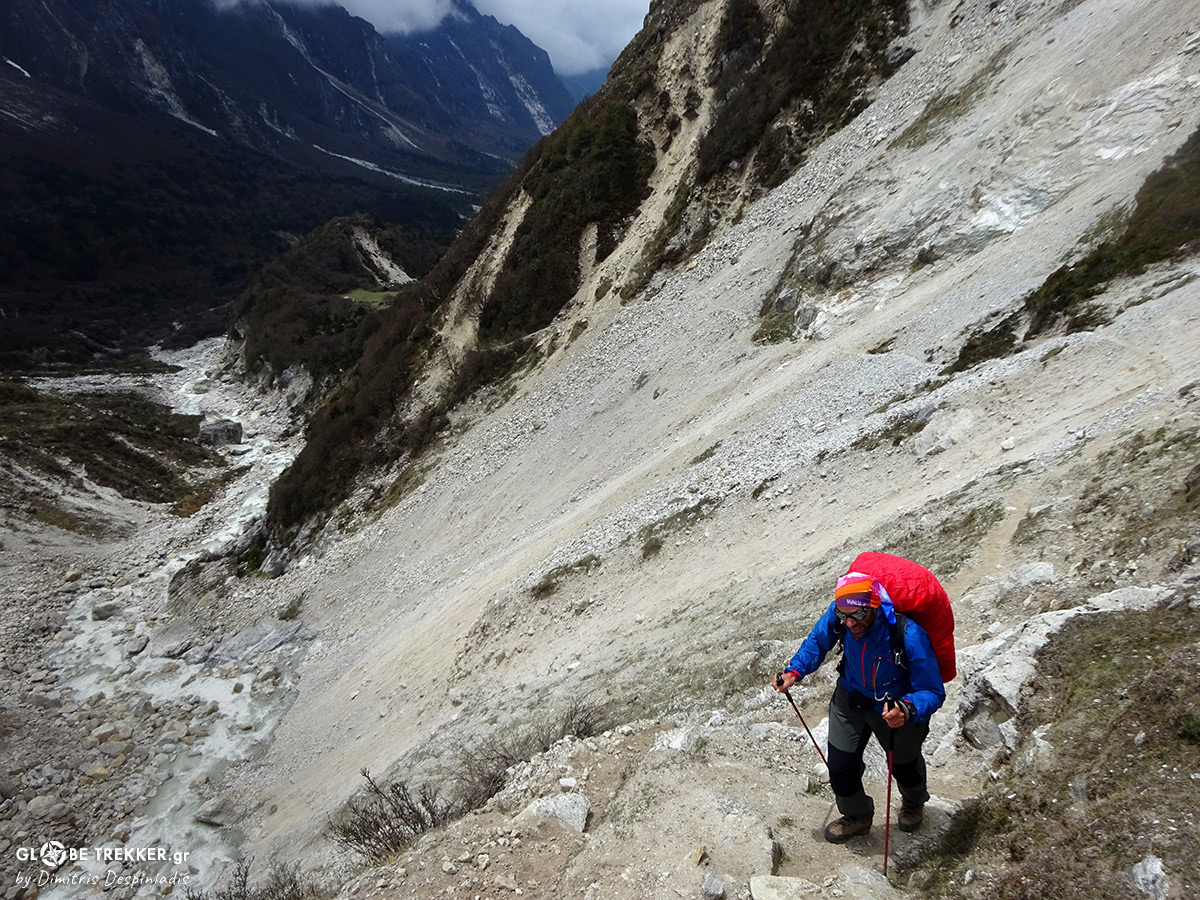
Khambachen (4145m)
Magical views unfolded in front of our eyes by sunrise ! The mist covering the base of the massive Jannu ( Kumbhakarna ) 7711m and its neighbors cleared, as the rising sun started warming their peaks !
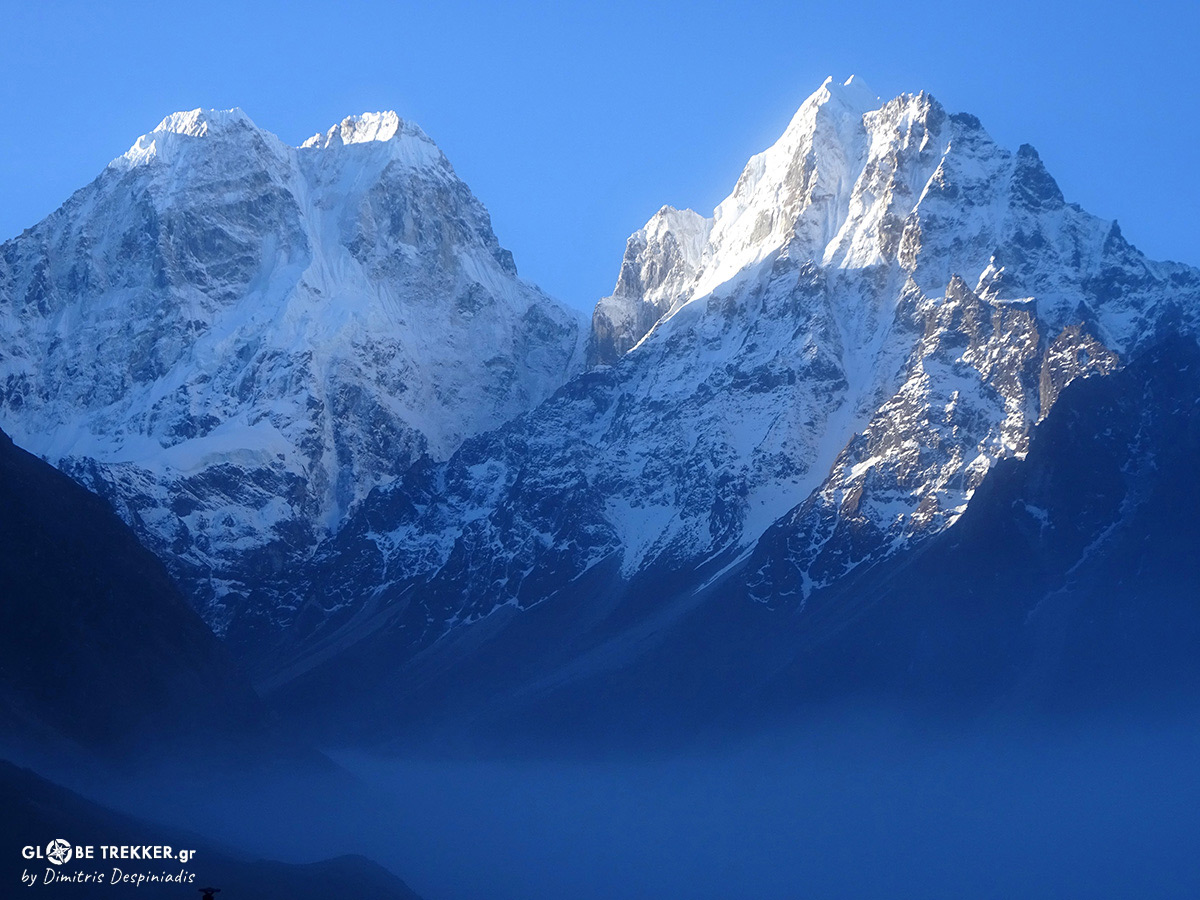

The upper ( quite vertical ) part of Kumbhakarna’s ( 7711m ) north face !
Amazing views to the east – with huge seracs hanging from massive faces – accompanied our hike to higher elevations as we were finding our way through ravines and boulder fields.

Kangbachen’s summit pyramid ( 7902m ) !
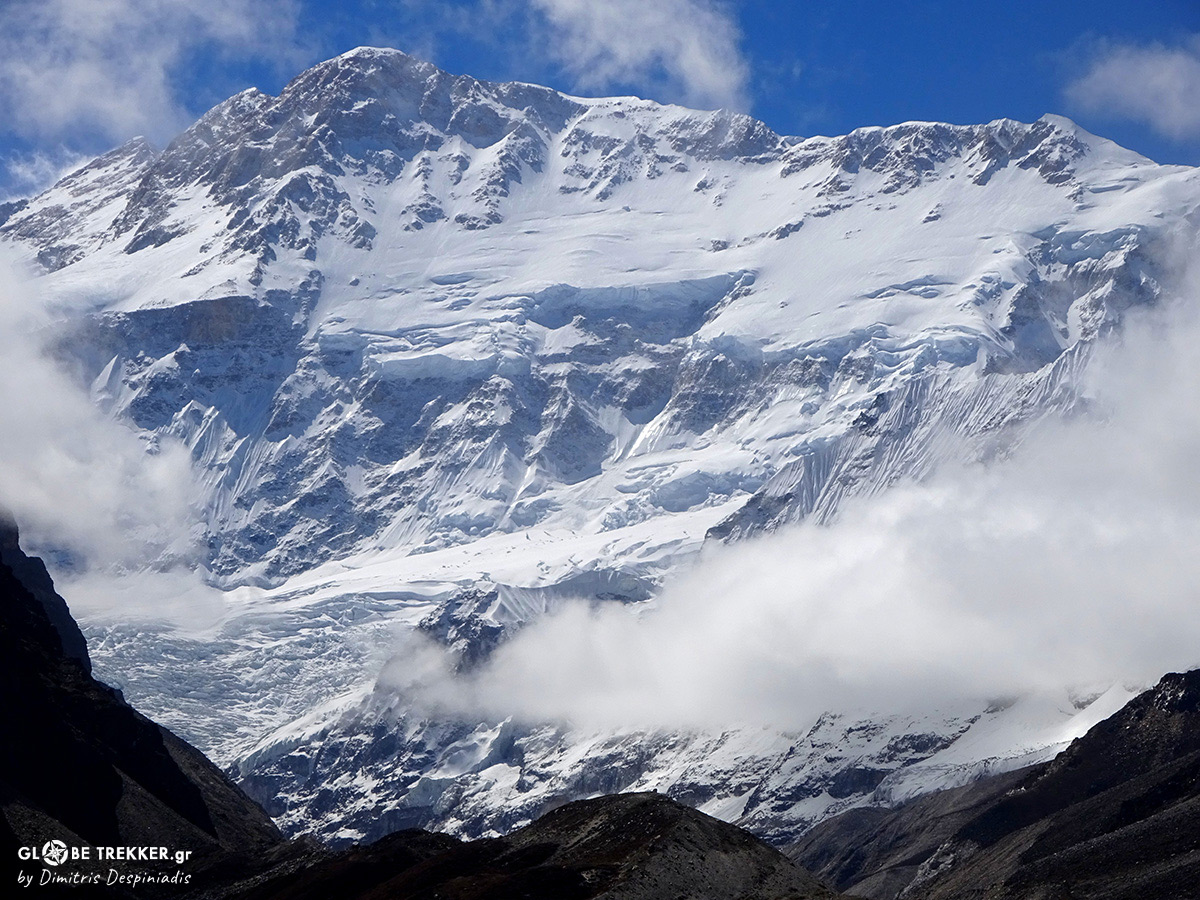
Kangchenjunga’s ( 8586m ) north face ! The group of its main summits forms a natural border between Nepal and India and is supported by long ridgelines that form a giant “ X ” !
After passing as carefully and fast as we could a few other landslides, we reached a sandy plain and a little bit later the huts at Llonak !
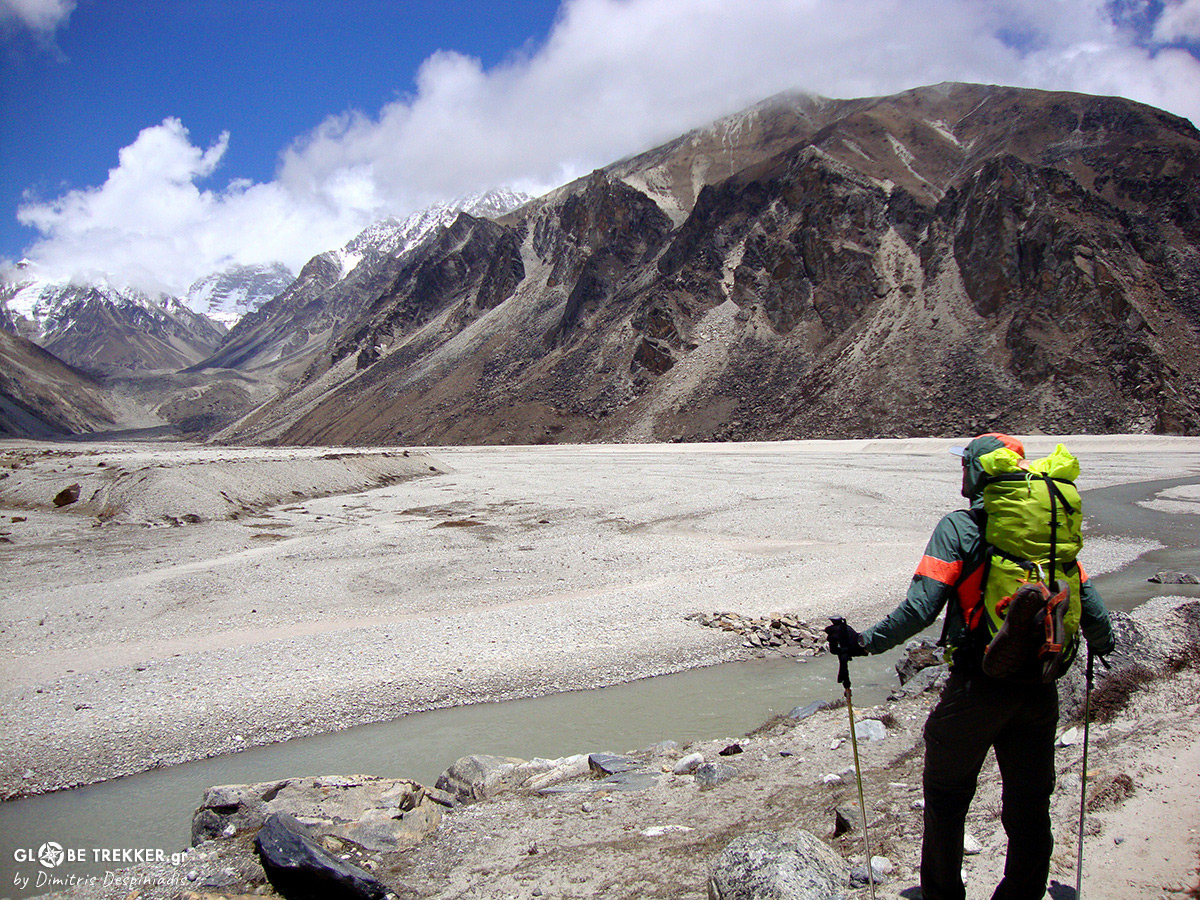
The Unexpected encounter
Beside the sandy plain, the huts were demarcated by the impressive Llonak glacier and slopes with intense signs of disintegration.
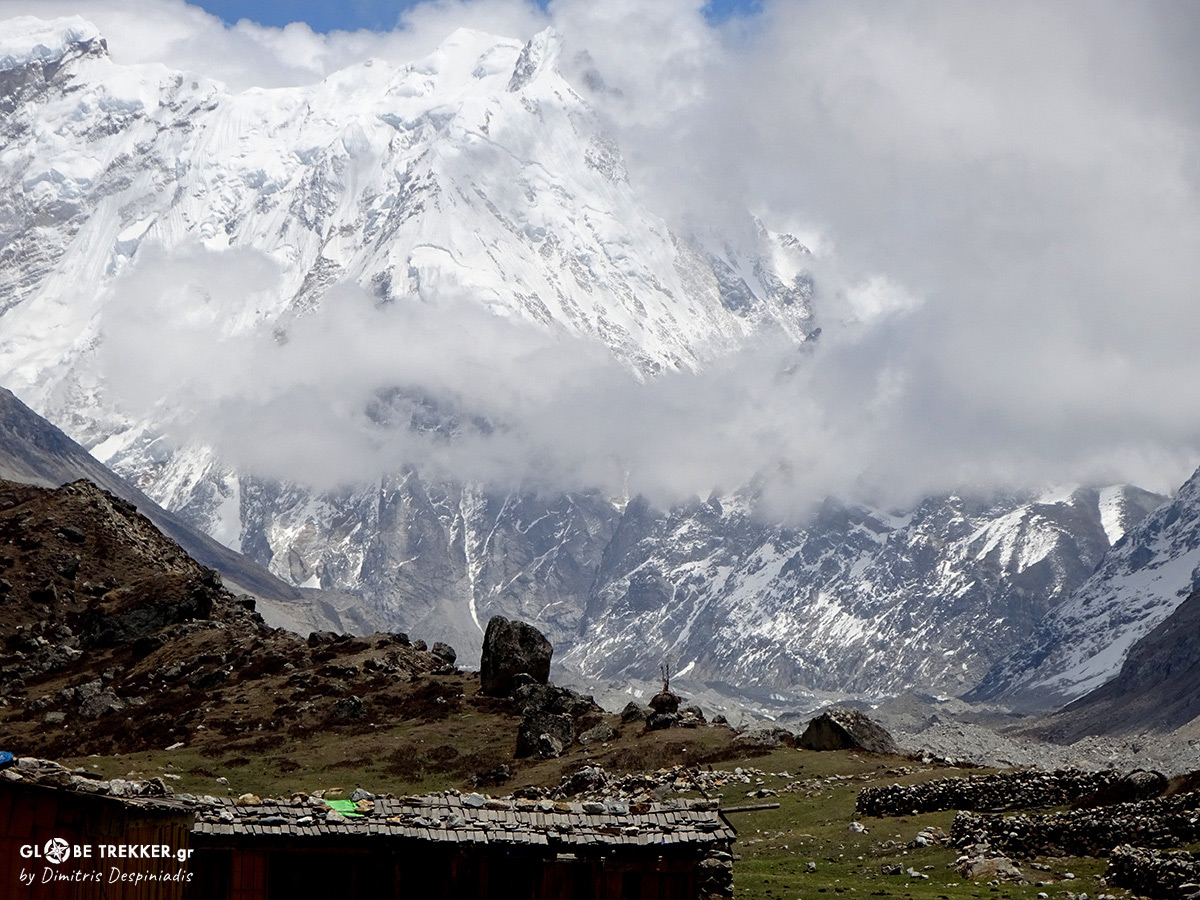
The perfect hiding place for the elusive Snow Leopard !
Clouds traveled really fast from the depths of the glacier revealing and disappearing again the nearby peaks !
A flock of Bharals ( the endangered Himalayan blue sheep ) came out from the moraine and started grazing less than 150 meters away from us !
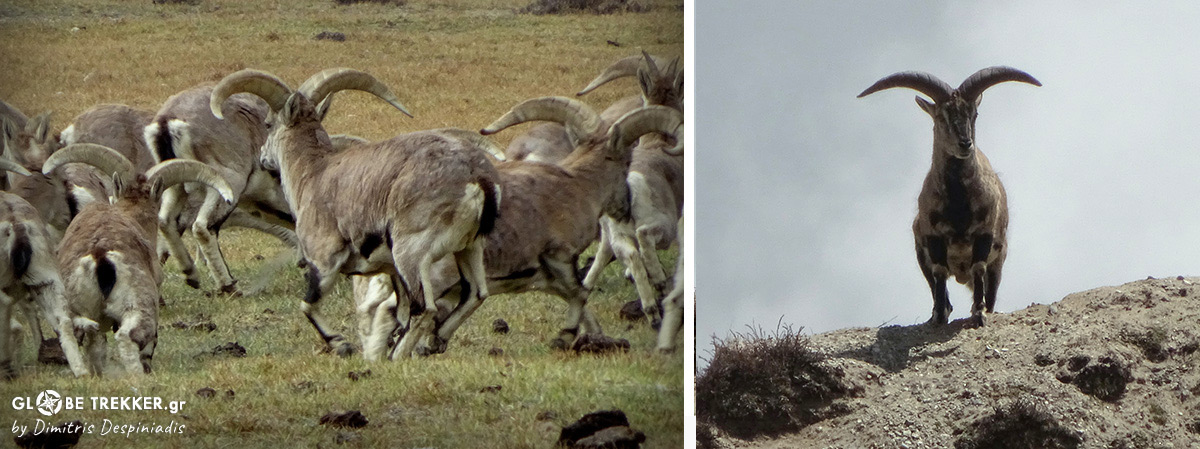
2 hours later – right before sunset – happened what I already mentioned in the prologue !
The next morning thick mist covered everything. Returning from Pang Pena ( 5150m ) – which in clear weather offers mesmerizing views of Kangchenjunga’s north face – and just 100 meters away from our hut the sun came out, revealing us a scene that we could not possibly imagine !
Right next to a rock were lying the dead bodies of an adult Bharal and an infant Snow Leopard. I remembered last day’s incident. Dimitris was right !
Presumably , the Snow Leopard attacked the Bharals with her cub and one of them ( possibly the one that was lying on top ) killed the cub in defense .
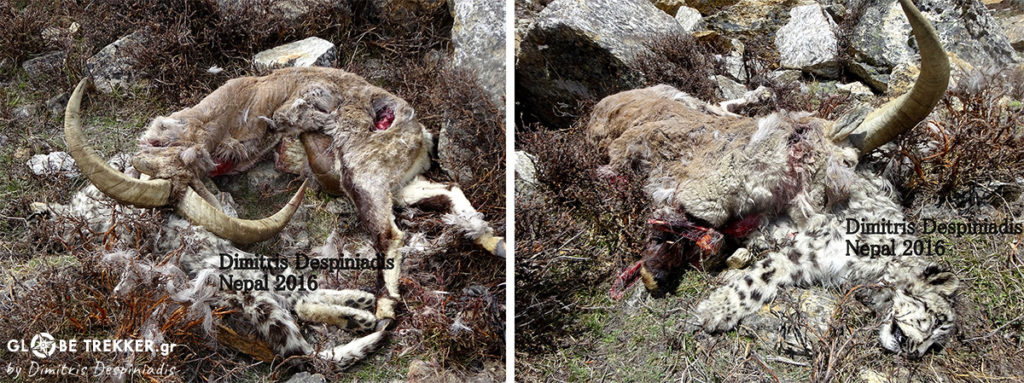
As I already knew how RARE is such a sight ( even with the animals dead ) I was more than surprised ! I would definitely prefer not to see a thing and the poor animals to live, but this is wildlife we are talking about and humans had nothing to do with this !
The Bhote who was running the hut was as much impressed as we were. It was the 1st time he was seeing a Snow Leopard, despite the numerous days he had spent here the last few years !
“ The adult Snow Leopard will return to eat !” he murmured.
I remembered that the guys from WWF told me that with the meat of an adult Blue Sheep a Snow Leopard can live for up to 2 weeks without hunting.
By the afternoon, while we were eating inside the hut, the Snow Leopard came, removed the carcass of the blue sheep 4 meters away and ate a lot !
When we found out later, our host covered the 2 carcasses with a thick piece of plastic and a cloth and sent his assistant to Ghunsa to inform them accordingly.
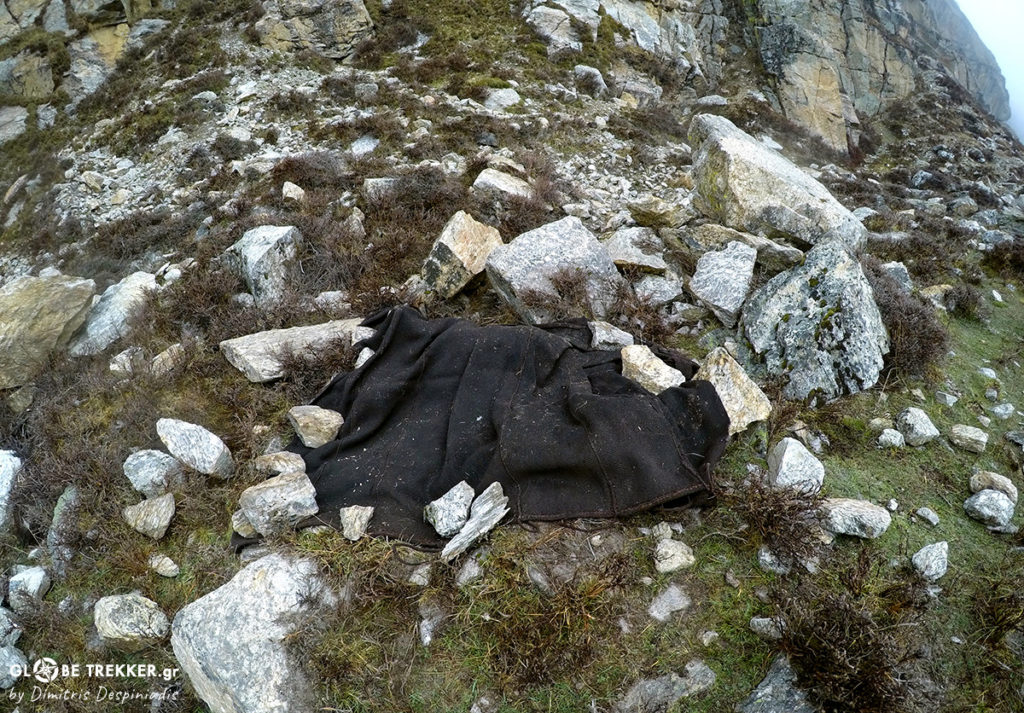
Right before dusk I started walking towards the location to take a video. Before getting really close I heard a wailing sound ! I stood still and looked with anxiety the area next to the rock !
A few seconds later I spotted a shadow – just like a ghost – disappearing to the dark couloir !
UNBELIEVABLE !
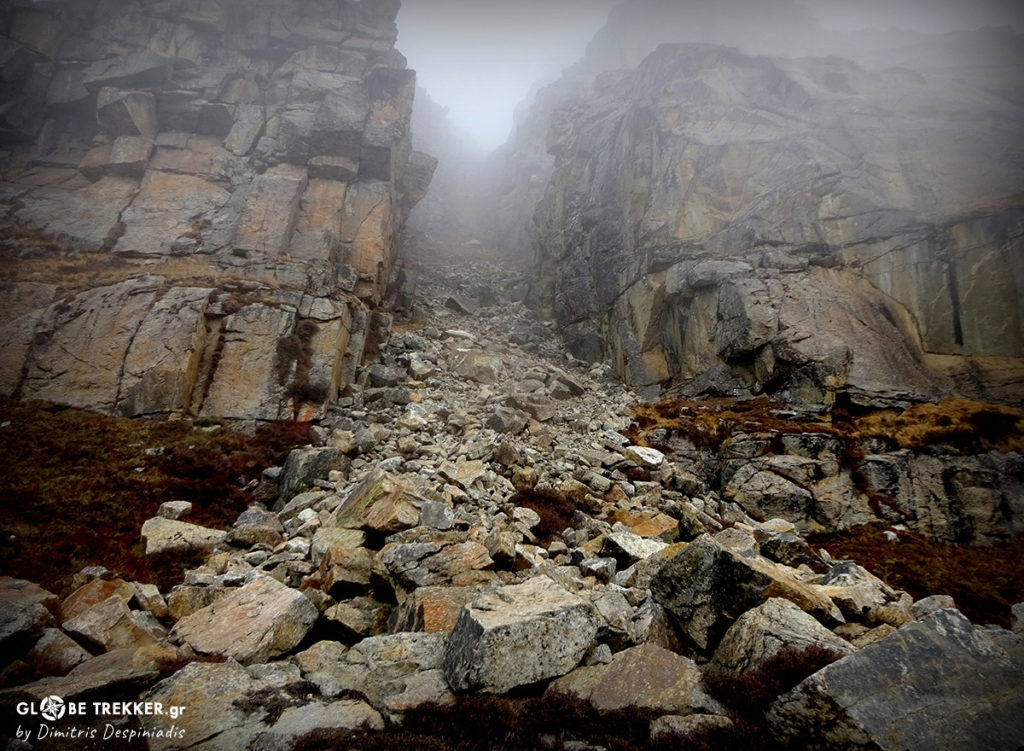
The whole night she was turning around the huts and wailing !
Our return
Everybody in Ghunsa has already heard the news when we came back and the owner of our lodge made us far too many questions !
A torrential downpour – that started in the afternoon and lasted till dawn – brought the snow line below 3700m.
The area surrounding the colossal Kanchenjunga massif is the first in Nepal that the monsoons hit on their journey from the Indian plains and we – as well as the villagers of Ghunsa – considered this downpour as their forerunner !
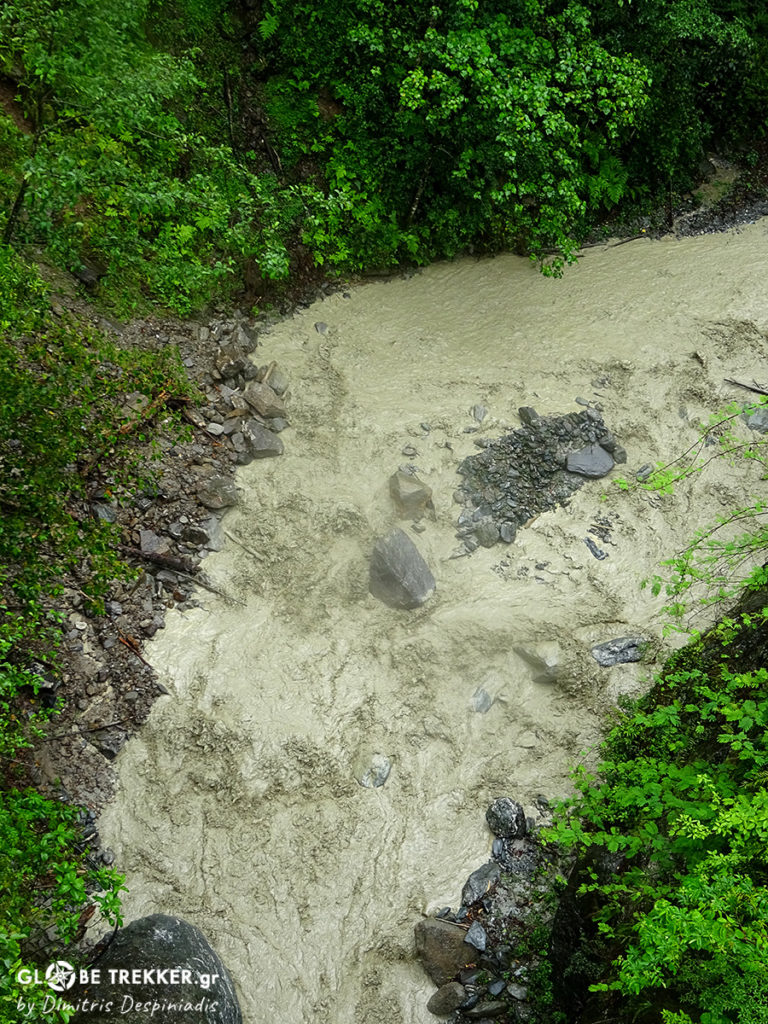
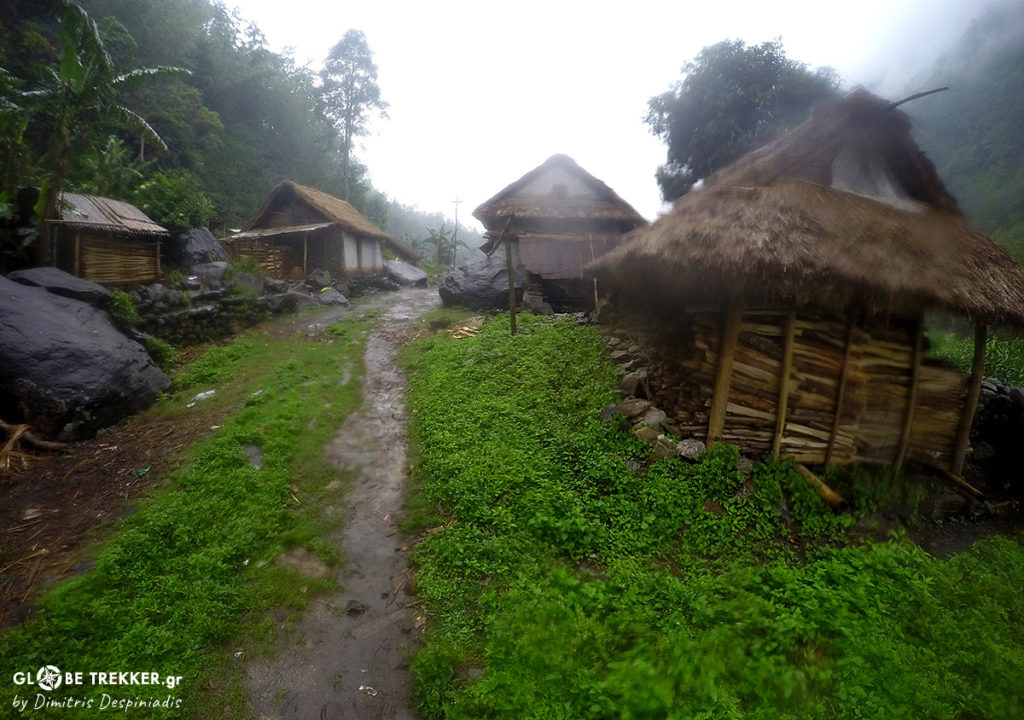
So, as we did not want more floods to make our return journey complicated, we forgot the thought of relaxing for a day in Ghunsa, and instead we followed the course of Ghunsa Khola and Tamor Nadi rivers and in 3 days – through semi flooded fields and bamboo forests – returned back to Taplejung !


Taplejung!
Every travel in the remote Himalayan regions is unique and EVERY SINGLE TIME a journey back in time ! The experiences gained were added to a “multicolored canvas” of experiences that have made me love deeply that special part of the globe !
The beauty of its ecosystems ( were I love to wander ) and the kindness of the people I cross paths with ( to whom I feel so familiar ) keep calling me back silently for more !
The next one I plan – and hope – to last a lot more !
#NepaliLoveyou
